ABQ 正在重新整理,将会持续更新,内容或有错误,仅供参考
本文 主要参考了 Gyrojeff 大佬的文章
Unit 1 Scientific Foundation of Psychology
Theoretical Approaches 理论研究方法
Structuralism 结构主义
- Theory 理论
- Focus: Structure of the mind
- 意识的结构`
- Consciousness could be broken down into its basic elements
- 意识可以拆分成一些基础元素
- Experience 经验
- Emotions 情绪
- Sensations 感觉
- 意识可以拆分成一些基础元素
- Focus: Structure of the mind
- Research Object 研究对象
- Consciousness 意识
- Research Method 研究方法
- Objective introspection 客观内省法(In laboratory conditions 在实验室里做的)
- Key People 代表人物
- Wilhelm Wundt 冯特: 心理学之父,在德国造了第一个心理学实验室
- Edward Titchener: 冯特的学生,把心理学带到了美国
- Historical Evaluation 历史上的评价
- 贡献
- 造就了现代科学的心理学:created modern scientific psychology
- 为心理学的发展奠定了基础:laid an important foundation for its development
- 限制
- 不切实际:out of touch the reality
- 分离了它的整体性:separates its entirety
- 过于主观,可重复性差:too subjective and irreproducible
- 贡献
Functionalism 机能主义
- Theory 理论
- Focus: How the mind allows people to function in the real world
- 意识的能动作用
- Consciousness → Continuous Whole
- 意识是连续的整体
- Focus: How the mind allows people to function in the real world
- Research Object 研究对象
- Functions of Consciousness 意识的功能
- Research Method 研究方法
- Objective Introspection 客观内省法
- Objective Observation 客观的观察
- Key People 代表人物
- William James: 写了第一本心理学教科书 Principles of Psychology
- Historical Evaluation 历史上的评价
- 贡献
- 促进了心理学的广泛应用 Promoted the wide application of psychology
- 限制
- 只研究了 Consciousness
- 贡献
Psychoanalytic / Psychodynamic 精神分析 / 精神动力学派
- Theory 理论
- All human behavior stems from sexual desire – Libido
- 人们的所有行为都源自于性欲 – 力比多
- 有潜意识(Unconscious)在作用
- Emphasize the role of early experience in physical and mental
development
- 强调早期经验对以后的影响
- All human behavior stems from sexual desire – Libido
- Research Object 研究对象
- Unconscious 潜意识
- Research Method 研究方法
- Hypnosis 催眠
- Dream Analysis 梦的解析
- Free Association 自由联想
- Life History 生活史法
- Key people 代表人物
- Sigmund Freud 弗洛伊德,梦的解析 Interpretation of Dream
- Jung Adler 精神动力学派的创立者
- Historical Evaluation 历史上的评价:
- 贡献
- 直到现在在临床方面(Psychiatry and Clinical
Psychology)还有很大的应用
- Unconscious motivation, defense mechanisms
- 梦的解析被称为 One of the major thought revolutions of mankind 人类思维的伟大革命之一
- 直到现在在临床方面(Psychiatry and Clinical
Psychology)还有很大的应用
- 限制
- 缺乏科学性
- Too much emphasis on the unconscious 太强调潜意识
- 过于强调 Sexual Desire
- 贡献
Behaviorism 行为主义
- Theory 理论
- 不研究意识,研究行为 Observable Behavior
- 反对内省法,要求科学客观
- 强调后天习得(learning)的重要作用,以及环境对行为的影响
- Research Object 研究对象
- Behavior
- Research Method 研究方法
- Experimental
- Key People 代表人物
- Ivan Pavlov 巴普洛夫:Classical Conditioning 经典条件反射
- John B. Watson 华生:Little Albert 实验 (响声 + White Rat)
- B. F. Skinner 斯金纳:Operational Conditioning 操作性条件反射:Skinner Box 实验
- Historical Evaluation 历史上的评价
- 贡献
- 把心理学引导到科学的道路上来
- 限制
- 太极端 Too Extreme,否认内部结构和意识的重要性
- 贡献
Gestalt Psychology 格式塔心理学
- Theory 理论
- 整体大于部分之和:The whole is greater than the sum of its parts
- \(1+1 < 2\)
- Research Object 研究对象
- Consciousness 意识
- Cognitive Phenomenon 认知 (Learning,Perception,Thought)
- Research Method 研究方法
- Experiment 实验
- Key people 代表人物:
- Max Wertheimer 韦特海默
- Wolfgang Köhler 柯勒
- Historical Evaluation 历史上的评价:
- Gestalt is true 格式塔心理学是对的
- Perception 感知 的原则已经留在教科书里了
Humanistic / Positive Psychology 人本主义 / 积极心理学
- Theory 理论
- Unique personality of humans 每个人都不同,关注人本身
- People can make their own choices and respect their needs 尊重每个人的需求
- Emphasizes the need for self-actualization 强调自我实现
- Optimistic View towards human nature 人性本善
- Perception of control is related to a sense of well-being 控制感 (感觉自己对事物有掌控力) 关系到幸福感
- Research Object 研究对象
- Personality 人
- Research Method 研究方法
- Holistic Analysis 整体分析
- Case Study 个案研究
- Key people 代表人物
- Rogers 罗杰斯:人本主义运动最杰出的领导者
- Maslow 马斯洛:需要层次理论(那个金字塔)Hierarchy of needs theory
- Historical Evaluation 历史上的评价
- 贡献
- the third force of psychology after Psychoanalysis and Behaviorism
- 人文主义关怀
- 限制
- 幸福感很难定义
- 忽略了环境因素 ignoring the influence of environment
- 没有明确的研究方法 no clear research method
- 贡献
Cognitive Psychology 认知心理学
- Theory 理论
- 认知是一种心理的过程 Cognition refers to the mental processes
- 处理数据来解释认知过程,比如说把人脑和电脑连起来 Use information processing to explain human cognitive processes, likening the human brain to a computer
- Research Object 研究对象:
- Information processing
- Research Method 研究方法:
- Reaction Time Recording 反应时法
- Oral Report 口头汇报
- Computer Simulation 电脑模拟
- Key people 代表人物:
- Jean Piaget 皮亚杰:研究儿童认知发展 children’s cognitive development
- Herbert Simon 西蒙:研究决策
- Historical Evaluation 历史上的评价:
- 从 1960s 开始成为主流
- Cognitive-neuroscience 认知神经科学
Other Key People 其他关键的人
G. Stanley Hall
- 第一任APA主席 (American Psychological Association)
- 研究development and evolutionary childhood psychology
Mary Whiton Calkins
- William James (研究 Functionalism 机能主义) 的学生
- 研究 Memory
- APA 第一位女主席
- 写了本书叫做 Animal Mind, 引发了 Behaviorism 行为主义的出现
Margaret Floy Washburn
- 第一位女性,心理学 PhD
- APA 第二位女主席
Dorothea Dix
- 建立精神病院,社会运动
1.2.5 Charles Darwin
- 进化论 Natural Selection Theory
Modern Approach 现代研究方法
Biological Approach 生物学方法
- 结合心理学和生物学,为人类行为提供生理学上的解释
- Combines psychology and biology to provide physiological explanations for human behavior
- 重点关注生理因素,如神经系统和内分泌系统
- Focus on physical factors such as nervous system and endocrine system
- 神经递质 Neurotransmitter 与 荷尔蒙 Hormone
Cognitive Approach 认知方法
- 注重心理过程 Mental Processes、感知 Perception 和语言
Language,作为解释和理解人类行为的一种方式。
- Also focuses on reasoning and cognitive tasks
- 记忆 Memory,语言 Language,问题解决 Problem Solving,智能
Intelligence
- e.g: AI, Problem Solving, Natural Language Understanding
Humanistic Approach 人本主义方法
- 强调个人内在的自我实现(Self-actualization)的价值和动力(实现和表达自己的能力和创造力的过程 the process of realizing and expressing ones own capabilities and creativity)
- 人作为整体看待,人性本善,自由意志
Biopsychosocial Approaches 生物社会心理学方法
- 强调心理需要考虑,生物和社会因素
- 考虑先天与后天的影响,人物与环境的共同影响
Social Cultural Approach 社会文化方法
- 社会文化对人的思想和行为的影响
- 关注社会习俗(Social Customs)、信仰(Beliefs)、价值观(Values)和语言(Language)如何塑造人的身份(Shape Person’s Identity)。
Evolutionary Approach
- 通过进化论和自然选择(Natural
Selection)解释心理现象,Darwin
- e.g. 爱产生的原因源于古时候的生活环境能够提高人的生存概率
Eclectism 折衷主义
- 缝合大师
心理学的分支
- Psychiatrist 开处方药的心理医生
- Clinical Psychologist 临床心理学家,研究心理疾病
- Psychometric 研究人类的能力、态度和特质,收集整合数据,开发量表
- Counseling Psychologist 心理咨询
- Developmental Psychologist 研究人从出生到死亡不同阶段的行为特征
- Organizational Psychologist 工业组织心理学家,研究工作相关的心理学
- Educational Psychologist 研究心理学在教育领域的应用
- Personality Psychologist 研究人的性格和特质
Research Methods 心理学研究方法
Experiment Method 实验相关
- Reliability 信度:结果可复现
- Validity 效度:结果正确
- Independent Variable 自变量
- Dependent Variable 因变量
- Irrelevant Variable 无关变量
- Confounding Variable 混淆变量
- Control Variable 控制变量
- Operational Definition 操作性定义
- 是根据可观察、可测量、可操作的特征来界定变量含义的方法
- 定义变量的方法
- 好处:别人可以复现实验
- Placebo Effect 安慰剂效应,因为预期和实验目的,改变了原本的行为
Experimenter Effect 实验者效应
- 主试在实验中可能以某种方式(如表情、手势、语气等)有意无意地影响被试,使他们的反应附和主试的期望。这种现象称为实验者效应。实验者效应又称实验期望效应。
- E.g. Rosenthal Effect 罗森塔尔效应 / Pygmalion Effect 皮格马利翁效应 (两个是一个东西)
Rosenthal Effect 罗森塔尔效应
- 罗森塔尔效应,亦称“皮格马利翁效应”、“人际期望效应”,是一种社会心理效应,指的是教师对学生的殷切希望能戏剧性地收到预期效果的现象。由美国心理学家罗森塔尔和L.雅各布森于1968年通过实验发现。一般而言,这种效应主要是因为教师对高成就者和低成就者分别期望着不同的行为,并以不同的方式对待他们,从而维持了他们原有的行为模式。
Case Study 个案研究法
- 内容:仔细研究一个人,detailed, e.g. Freud (弗洛伊德); Gage
- Advantage: 非常详细
- Disadvantage: 难以推广 Cannot really apply the results to other similar people.
Longitudinal Studies 纵向研究法
- 内容:same variable, long time:长时间研究一个东西
- Advantage:
- 完整的发展过程 complete development process
- 看得到转折点 key turning point
- Disadvantage:
- 耗时长,累 time-consuming and laborious
- 实验对象很容易放弃,流失 easy to lose subjects
- Exercise Effect 练习效应:一件事情做久了,熟练了
- Fatigue Effect 疲劳效应:一件事情做多了,不耐烦了,做起来不认真了
Cross-sectional Studies 横向研究法
- 内容:different population groups, same time:同一个时间,研究不同的群体
- Advantage:
- 省钱省力省时间
- Disadvantage:
- 不能看到完整的发展过程
- 不能看到关键的转折点
- Intergenerational Effects (代际效应) and age factors confound –
代际效应和年龄这两个变量可能会混淆。
- 组间变量受到 Confounding Variables 的干扰
Experiment Approach 实验方法
Double Blind 双盲
- 实验者和被试者都不知道组别
Single Blind 单盲
- 被试者不知道组别,实验者知道
Random Assignment 随机分配
- 每个参与者分配到不同的组都有均等的概率
- 控制 Participant Difference (bias),也就是 Cross-sectional 的组间差异
- 随机分配与否决定能否通过实验得到因果关系
Random Selection / Sampling 随机抽样
- 这样得到的 Sample 是 Representative Sample,降低 Sampling Bias
- 决定能否通过抽样代表整体
Observations 观察方法
Naturalistic Observations 自然观察法
- 内容:直接看,最简单,最原始的办法 Easiest and most primitive way of observation
- Advantages: Realistic
- Disadvantages
- Observer Bias 观察者偏差,因为当人/动物知道自己在被别人观察的时候会表现的不一样,这就是 Observer Effect 观察者效应
- 每次的观察环境都是特殊的独特的,难以推广 (unique)
- 可能会观察到和实验无关的现象,比如说突然下雨
Laboratory Observation 实验室观察法
- 内容:One-way Mirror,或者有可能有研究者混在参与者里面
- Advantages:
- Control, 控制程度更高
- Disadvantages:
- Artificial situation (人工的环境) –> Artificial Behavior (表演的反应)
Surveys 调查法
- 内容:顾名思义,发问卷
- Advantages
- 获取隐私信息 get private information
- 数据量大
- 不被地方或时间所限制
- Disadvantages
- 可能会被骗
- sampling bias 样本偏差 (难以选出代表性样本 representative sample)
- Under coverage bias 覆盖不全偏差
- Nonresponse bias 不回答偏差
- FRQ 中问到 Overestimate / Underestimate
- 都可以说,但理由要合理,一般选 Overestimate 即回答了的人过拟合了
- FRQ 中问到 Overestimate / Underestimate
- Response bias 错误答案偏差
- Wording of question 问题偏差
Correlation Studies 相关性研究
- 衡量两个变量之间的相关性
- Advantages:
- 可以预测心理现象 people’s psychological phenomena can be predicted
- 作为further study的basis
- Disadvantages:
- 有效性和准确性受限制 limited validity and reliability
- 相关不等于因果
Experimental Study 实验
- Advantage
- 可以得出因果关系 cause and effect
- 精确 precise
- Disadvantage
- 可推广性差
Ethical Guidelines in Psychology 伦理规定
For Human 对人而言
- Rights and well-beings of participants must be weighed against the study’s value 参与者的权力和幸福更重要
- Informed consent 知情同意
- Participants must be allowed to make an informed decision about participation
- No coercion 不强迫
- Participants may withdraw from the study at any time 随时可以退出
- Little Risk 风险限制
- Participants must be protected from risks or told explicitly of risks 必须被保护/告知危险
- Participants cannot be placed at significant mental or physical risk
- Debriefing 事后告知
- Investigator must debrief participants, telling the ture nature of the study and expectations of results. 必须时候告知被试实验目的
- After study, participants should be told the purpose of the study
- Deception must be justified 如果欺骗了,一定要澄清
- Anonymity or confidentiality 匿名保密
- Data must remain confidential 保密数据一定要保密
For Animal 对动物而言
- They must have a clear scientific purpose. 必须要有清晰的科学的目标
- The research must answer a specific, important scientific question. 研究必须是要能解决科学问题的,非必要不做实验
- Animals chosen must be best-suited to answer the question at hand. 选择的动物一定是要适合研究的问题的
- They must care for aid house animals in a humane way. 必须好好善待动物,有饭吃有屋住
- They must acquire animal subjects legally. 必须从合法渠道得到动物
- They must design experimental procedures that employ the least amount of suffering feasible. 必须设计实验步骤,并且让动物受到最小的痛苦
Unit 2: Biological Basis of Behavior
Interaction of Heredity and Environment 遗传和环境的相互作用
Gene 基因
- Traits 性状
- Genotype 基因型
- Homozygous 纯合子
AA, aa- Dominant Homozygous 显性纯合子
AA - Recessive Homozygous 隐性纯合子
aa
- Dominant Homozygous 显性纯合子
- Heterozygous 杂合子
Aa, aA
- Homozygous 纯合子
- Dominant Gene 显性基因,指在一对具有相对性状基因控制的杂合子中,能使其表现出性状的基因或指对该性状有决定性作用的基因
- Recessive Gene 隐性基因,指这样的一种等位基因,只有该基因是纯合时,其决定的性状才会表达出来。在杂合的状态下, 生物体的表型显示显性基因决定的特征
- Phenotype 表型,即基因的最终表现

Genetic Disorder 遗传疾病
Down Syndrome 唐氏综合症
唐氏综合征即 21-三体综合征,又称先天愚型或 Down 综合征,是由染色体异常(多了一条21号染色体)而导致的疾病。60% 患儿在胎内早期即流产,存活者有明显的智能落后(Mental Retardation)、特殊面容、生长发育障碍和多发畸形。
Klinefelter’s Syndrome 克氏综合征
先天性曲细精管发育不全综合征又称为克兰费尔特综合征(Klinefelter 综合征)是一种较常见的一种性染色体畸变的遗传病。本病特点为患者有类无睾身材、男性乳房发育、小睾丸、无精子及尿中促性腺激素增高等。本病患者性染色体为 47,XXY,即比正常男性多了 1 条 X 染色体,因此本病又称为47,XXY 综合征。
- Testicular Dysplasia 睾丸发育不良
Turner’s Syndrome 特纳氏综合征
先天性卵巢发育不全是由 Turner 在 1938 年首先描述,也称 Turner 综合征。临床特点为身矮、生殖器与第二性征不发育和一组躯体的发育异常。智力发育程度不一。寿命与正常人相同。母亲年龄似与此种发育异常无关。
- Congential agenesis of ovaries 卵巢发育不良
Huntington’s Chorea 亨廷顿舞蹈症
亨廷顿舞蹈症(Huntington’s disease, HD)是一种罕见的常染色体显性遗传病。患者一般在中年发病,出现运动、认知和精神方面的症状。亨廷顿舞蹈症临床症状复杂多变,患者病情呈进行性恶化,通常在发病 15~20 年后死亡。起病隐匿,进展缓慢,以舞蹈样动作伴进行性认知、精神功能障碍终至痴呆为该病的主要特征。病因是亨廷顿基因上多核苷酸重复序列的错误表达,从而影响不同的分子通路,最终导致神经功能失调和退化。
Rett’s Syndrome 综合征
Rett 综合征是一种神经发育障碍,几乎只见于女性。 患者出生后初期有短暂的正常发育,然后丧失已获得的功能(语言和手的功能)、出现手部刻板动作和步态异常。 其他表现包括头围增长减慢、癫痫发作、孤独症样表现和呼吸异常。
Musle Impairment 肌肉缺陷
Key People 重要人物
- Darwin, Evolution 达尔文,进化论 — Natural Selection 物竞天择
- Gregor Mendel 孟德尔 — 豌豆实验,基因
- Robert Plomin — Genetics Researcher 基因研究者
Endocrine System 内分泌系统
- 通过腺体(Glands)释放激素(Hormones)完成工作
- 内分泌是一个长期过程,与神经递质不同在于,内分泌通过血液系统抵达身体各个部位,而神经递质直接作用在神经元上
- Hypothalamus 下丘脑:神经系统与内分泌系统之间的桥梁,受神经系统控制,还可以分泌激素控制垂体
- 垂体 Pituitary Gland:基础腺体,释放激素(如促甲状腺激素 Thyrotropin)控制其它腺体,垂体(Pituitary Gland)被下丘脑(Hypothalamus)控制
- 松果体 Pineal body:脊椎动物脑中,小腺体,人体最小的器官。它负责制造褪黑素(Melatonin),影响昼夜节律
- 肾上腺 Adrenal Glands:分泌肾上腺素(Adrenaline)和去甲肾上腺素(Norepinephrine),来准备身体的 Fight or Flight,和应对压力
- 卵巢与睾丸 Ovaries and Testes:分泌性荷尔蒙(雌激素 Estrogen,雄激素 Testosterone),影响细胞生长和繁殖。
- 甲状腺 Thyroid Glands:分泌甲状腺素(Thyroxine),影响细胞代谢。
- 甲状旁腺 Parathyroids:小腺体, 控制我们血液(Blood)和骨骼(Bone)中的钙(Calcium)含量。
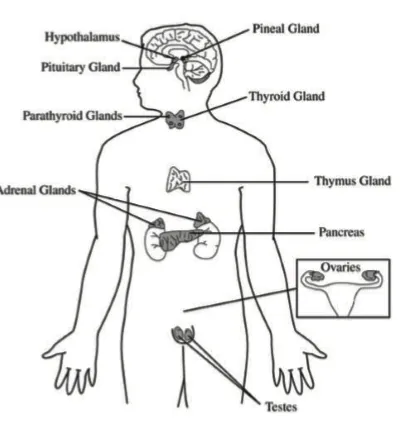
Overview of the Nervous System and the Neuron 神经系统概述
Types of the Neuron 神经元种类
- Afferent(传入) Neurons / Sensory(感觉) Neurons 上行神经元:从 PNS(具体感官) 到 CNS(主控);
- Inter-neurons 间神经元:上行神经元传完到大脑,中间神经元(Inter-neurons)负责进一步传递到具体的大脑脑区 或 去下行神经元(Motor Neurons)上
- Efferent(传出) Neurons / Motor(运动) Neurons 下行神经元:从 CNS(主控) 到 PNS(具体感官)
Gray Matter, White Matter 灰质,白质
- 灰质 Gray Matter — 神经中枢 — 控制,起支配作用
- 白质 White Matter — 起传导作用
- 脊髓 Spinal Cord — 外白内灰
- 大脑 Brain — 外灰内白
Structure of the Nervous System 神经系统的结构
- Central Nervous System CNS 中枢神经系统
- 包括 大脑(Brain) 和 脊髓(Spinal Cord)
收集身体信息并传递到 大脑 与
外周神经系统(PNS)
- CNS 信息 → PNS
- 神经元被捆绑成一串串相互连接的神经元,称为神经
- Brain
- An organ that serves as the center of the nervous system
- Spinal Cord
- The neurons are bundled into strands of interconnected neurons known as nerves
- Reflexes: movements that are controlled by direct transmission from afferent to efferent cells at the level of the spinal cord 反射(例如遇到烫的东西缩手)是由脊椎处理,而不是大脑
- Cerebrospinal Fluid 脑脊液 : A protective liquid the brain and the spinal cord are bathed in
- 包括 大脑(Brain) 和 脊髓(Spinal Cord)
收集身体信息并传递到 大脑 与
外周神经系统(PNS)
- Peripheral nervous system PNS 外周神经系统
- Sensory (Afferent) 感官 Division:从 PNS(具体感官) 到 CNS(主控)
- Motor (Efferent) 运动 Division:从 CNS(主控) 到 PNS(具体感官)
- Autonomic: Sympathetic & Parasympathetic
自主神经系统(交感神经)
- 不可控自动系统(Involuntary Nervous System),如心肌,肺(膈肌),腺体(Cardiac Muscle, Smooth Muscle, Glands)
- 控制对压力的反应(fight or flight 应激反应)
- Sympathetic 交感神经系统,加速心率血压呼吸,减缓消化(使机体应激化)
- 瞳孔放大 — Dilates pupils
- 心率增加 — Increase heart rate
- 支气管扩张 — Dilates bronchi, Increase respiration
- 消化腺分泌减少, 胃肠道蠕动减少 — Decreases digestive functions of stomach (胃), pancreas (胰), and in testlines (肠)
- 抑制膀胱收缩 — Inhibits bladder contraction
- 抑制泪腺 — Inhibits tear glands
- Parasympathetic 副交感神经系统,让身体“减速”(使机体恢复)。
- Slowing down our body after a stress response
- Decelerate: heart rate, blood pressure respiration
- Accelerate: digestion
- Slowing down our body after a stress response
- Sympathetic 交感神经系统,加速心率血压呼吸,减缓消化(使机体应激化)
- Somatic Nervous System 躯体神经系统
- 可控神经系统(Voluntary Nervous System)
- 控制 有意识的肌肉运动(Voluntary Muscle Movements)
- Autonomic: Sympathetic & Parasympathetic
自主神经系统(交感神经)
The Route in PNS 外周神经系统的传导路径
- Sensory Nerves 感官神经(PNS) →
- Spinal Cord 脊髓 (Afferent Nerves 传入神经)→
- Sensory Cortex 感觉皮层 (CNS)
- Spinal Cord 脊髓 (Afferent Nerves 传入神经)→
- Motor cortex 运动皮层 (CNS)→
- Spinal Cord 脊髓(Efferent Nerves 传出神经)→
- Muscles 肌肉 (PNS)
- Spinal Cord 脊髓(Efferent Nerves 传出神经)→
Neural Firing 神经元的信号传递
Structure of Neurons 神经元的结构
- Dendrites 神经树突 Receive 信号
- Cell Body 胞体(又名Soma),提供营养物质
- Axon 轴突 Passage 信号
- Myelin Sheath 髓磷脂(保护 + 跳跃式加速传导),由 施旺细胞(Schwann Cells)组成
- Nodes of Ranvier,兰氏结,兰氏结是神经元上每隔数毫米就会出现的没有髓鞘的部分
- Neuron Gap 神经元空隙,也就是 Terminal Buttons(或 Axon Ending)
和下一个神经元的神经树突(Dendrites)之间整个的部分叫
突触(Synapse),Axon Ending 不是 Synapse
- 神经元不含突触
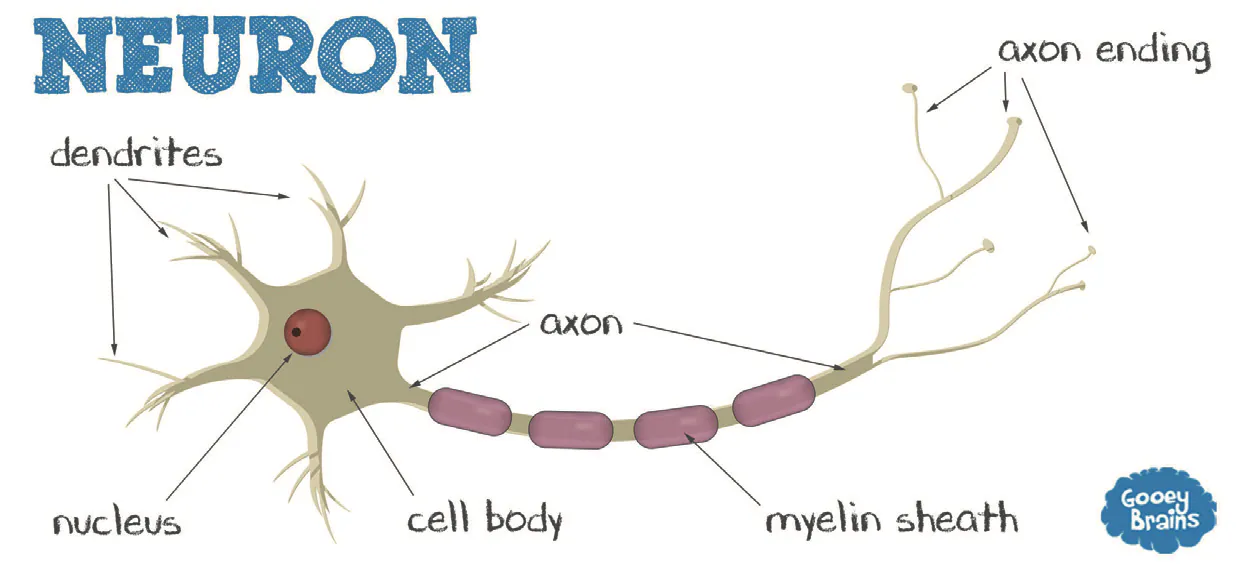
Neuron Firing 神经元的信号传递
- 初始状态,静息电位(Resting Potential) \(\pu{-70 mV}\),处于这种初始状态的过程叫做
极化(Polarized)
- 由钠钾离子泵(Sodium-potassium Pumps)控制,消耗 ATP 能量,通过控制离子的进出,保持 \(\ce{Na+}\) 在外和 \(\ce{Cl-}\),\(\ce{K+}\)在内,使得膜电位控制在 \(\pu{-70 mV}\)
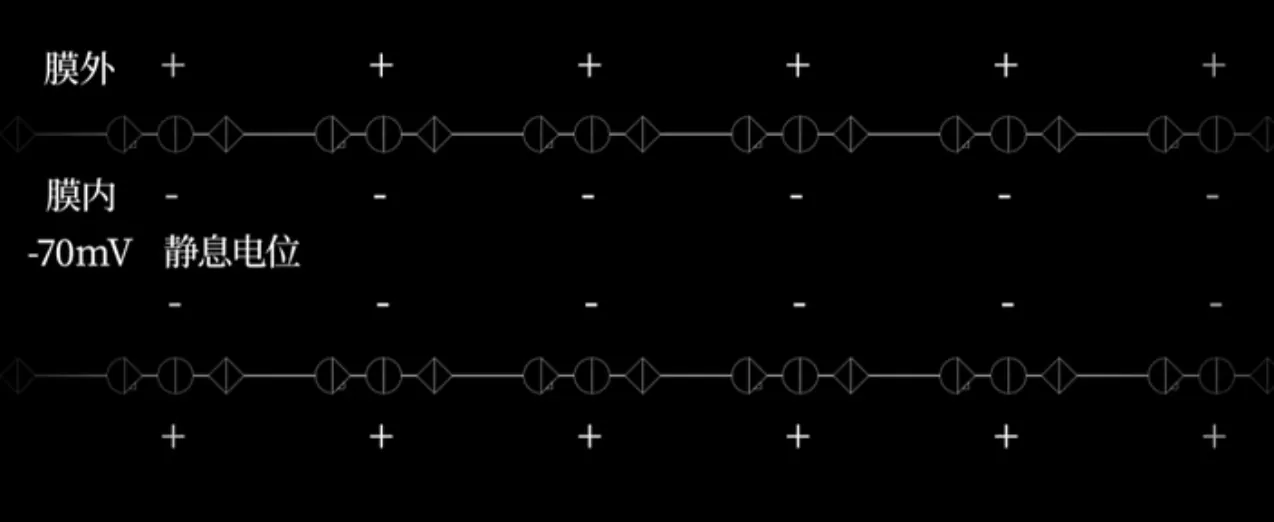
- 脉冲发送(Action Potential),激活条件是在轴突(Axon),与胞体(Cell
Body),相连之处(亦称轴丘 Axon Hillock)的膜电位升到 \(\pu{-55 mV}\)
- 发送电脉冲的过程是去极化(Depolarized),通过电压门控钠离子通道(Voltage-gated Sodium Ion Channels),这些蛋白质会当膜电位升到 \(\pu{-55 mV}\) 时开门(All-or-None Principle),允许钠离子涌入,使得膜电位迅速飙升到 \(\pu{+40 mV}\)
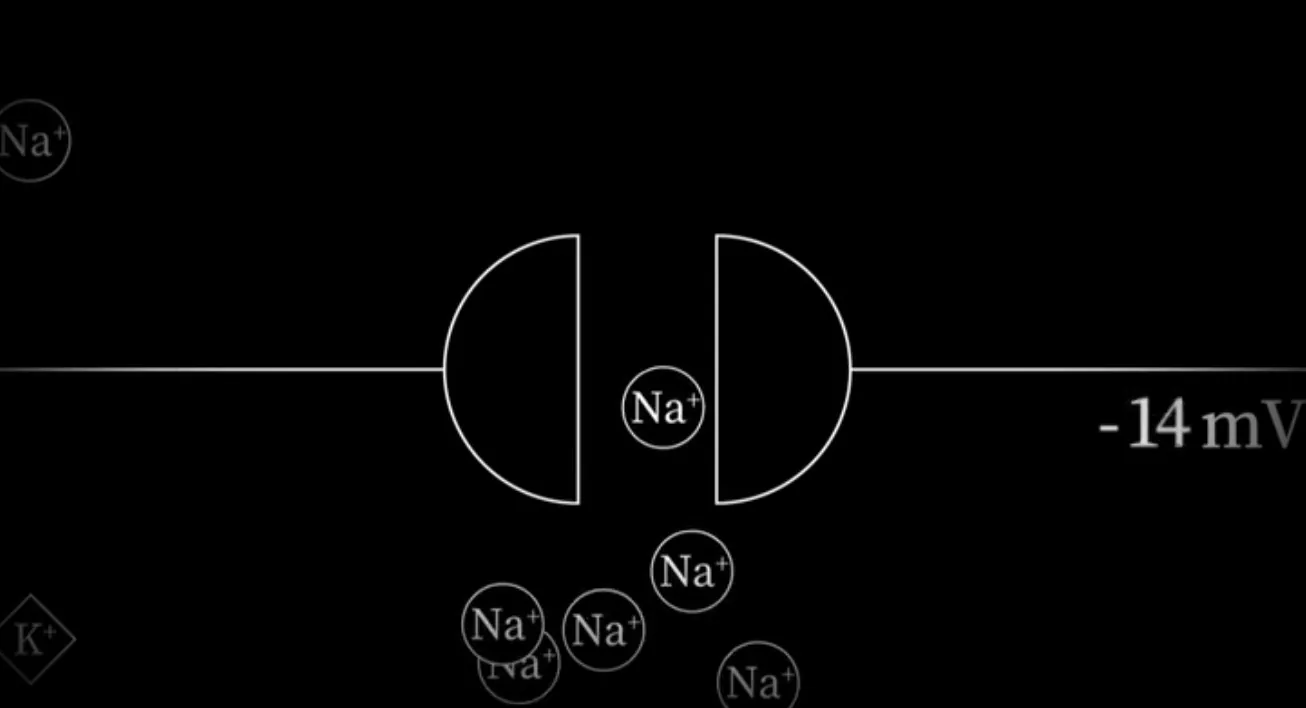
- 连锁去极化,形成动作电位,一直传导到与其他神经细胞连接处,也叫突触(Synapse)
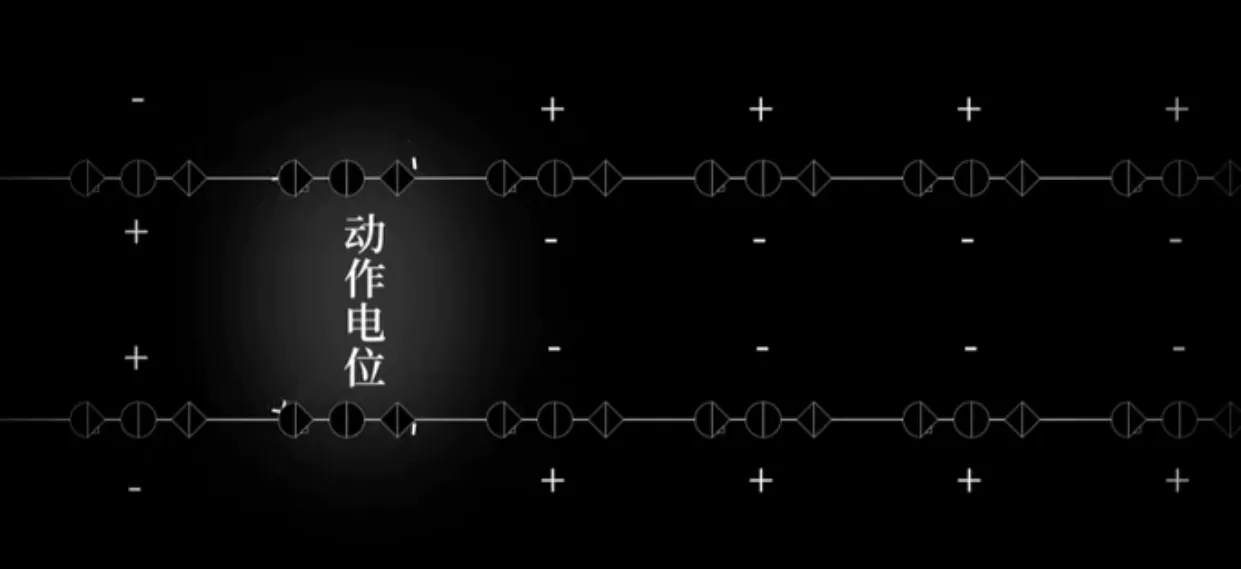
- 髓鞘(Myelin Sheath)包裹 轴突(Axon)使得轴突间动作电位只能在中断的部分,兰氏结(Nodes of Ranvier),可以跳跃式传导(Saltatory Conduction)
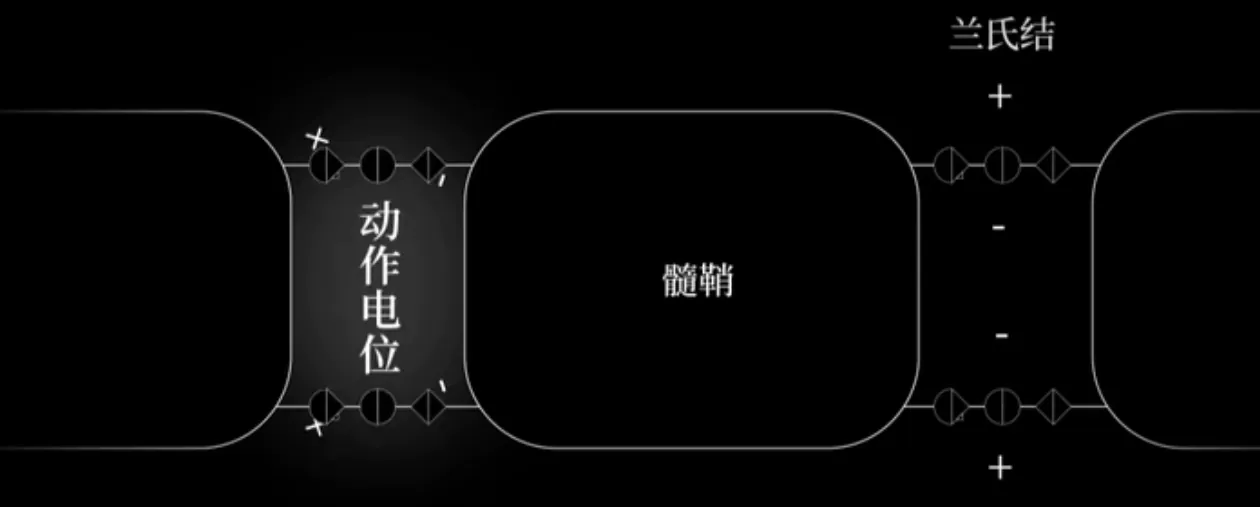
- 神经元复位,再极化(Repolarization),回到初始状态
- 再极化通过电压门控钾离子通道(Voltage-gated Potassium Ion Channels),这些蛋白质会当膜电位升到 \(\pu{-55 mV}\) 时开门,允许钾离子涌出,使得膜电位迅速下降到低于 \(\pu{-70 mV}\),最后再由钾离子泵(Sodium-potassium Pumps)稳定到 \(\pu{-70 mV}\)
- Refectory Period 不应期 神经元不反映的时候
- Absolute Refectory Period 绝对不应期,给多少都不反应
- Relative Refectory Period 相对不应期,刺激比之前要更多才反应
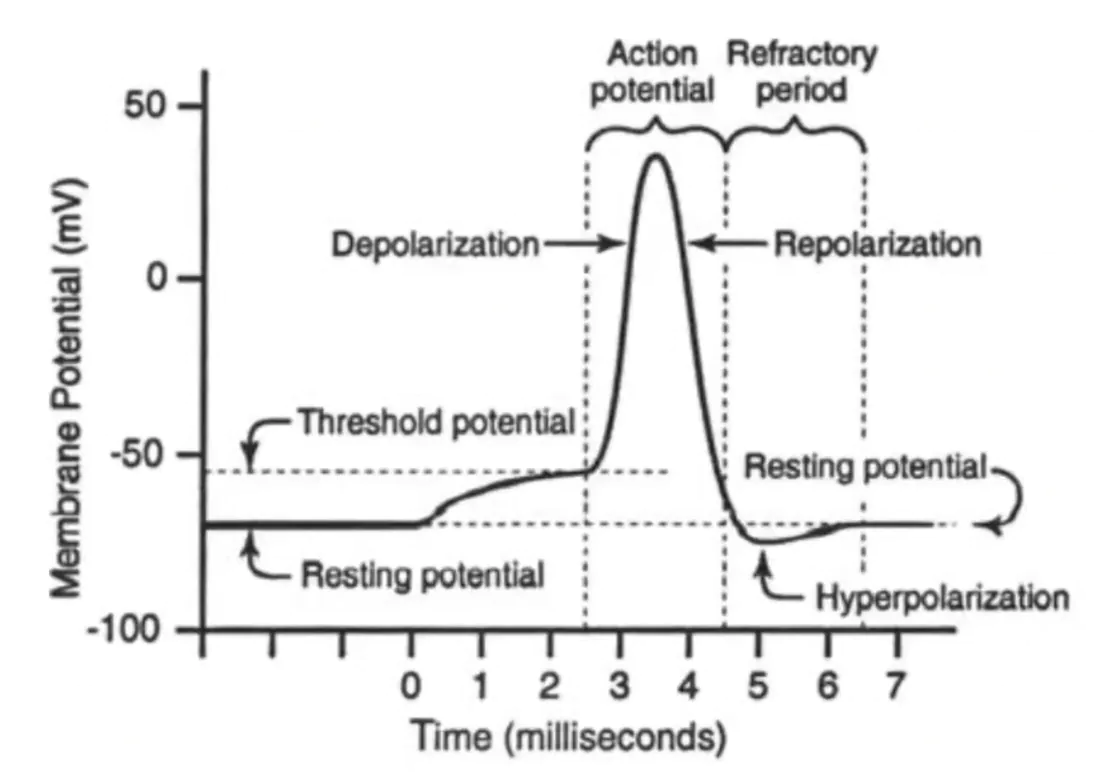
信息在突触 Synapse上的传递
- A junction between two nerve cells, consisting of a
minute gap across which impulses pass by
diffusion of a neurotransmitter
- 神经元以 轴突末梢 与其他神经元的 细胞体或树突 相接触的细胞膜合称为 突触 Synapse
- 突触由 突触前膜(Presynaptic Membrane),突触后膜(Postsynaptic Membrane),突触间隙(Synaptic Cleft)构成
- 当动作电位到达轴突末端时,轴突中的一些 突触小泡(Vesicles) 与 突触前膜 融合(Fuse),其内所含的 神经递质(Neurotransmitter)被排入 突触间隙,他们与 突触后膜 上的 受体(Receptor) 相结合,引起突触后膜的 膜电位 发生变化,直至激发,兴奋由此传递到下一个神经元。随后,神经递质很快就被突触间隙的 酶(Enzyme) 催化降解,失去活性,作用终止。
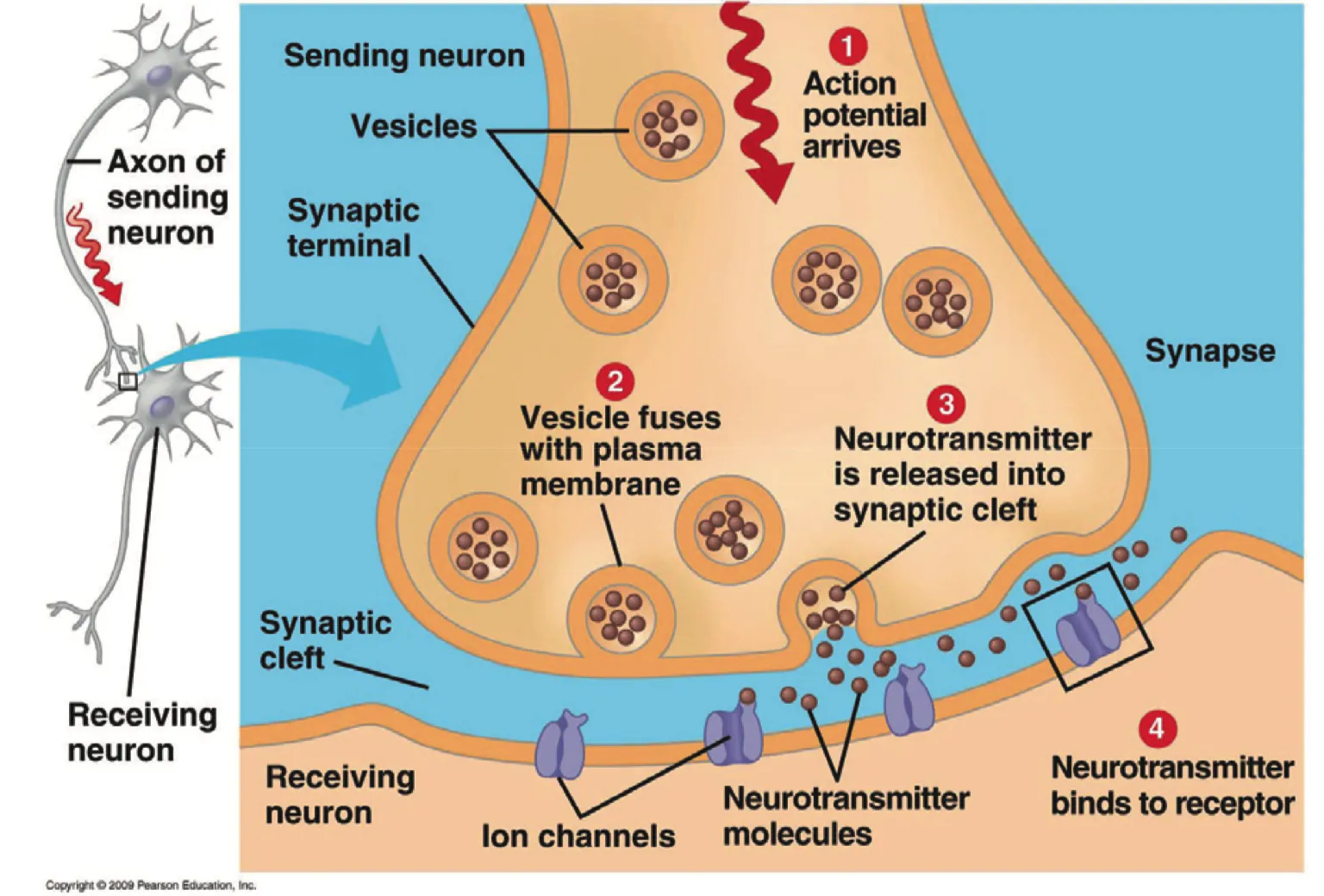
Neurotransmitters 神经递质
- Acetylcholine(ACH)乙酰胆碱
- 控制肌肉,维持意识的清醒,在学习记忆中起重要作用,释放不正常会导致瘫痪(Paralyze)
- 缺失会导致阿兹海默(Alzheimer)
- Dopamine 多巴胺
- 运动,注意力集中,与奖励(Reward)
- 缺失 → 帕金森病(Parkinson’s Disease)
- 过多 → 精神分裂(Schizophrenia)
- Endorphins 脑内啡类吗啡
- 镇痛激素,与药物成瘾有关。
- 阿片类药物 Opiate Drugs
- Serotonin 血清素
- 清醒,亢奋,睡眠,疼痛感觉,情绪与饥饿控制
- 缺失会导致抑郁症(Depression),过多会发生血清素综合征
- GABA
- 抑制性(Inhibitory)神经递质
- 抗焦虑(Antianxiety),喝酒后大量释放
- 缺失会导致失眠,不安(Restlessness),癫痫(Seizure)
- Glutamate 谷氨酸盐
- 激活性(Excitatory)递质,与 GABA 抵消
- 参与记忆的形成,过量会导致偏头痛(Migraines),癫痫。
- Norepinephrine 去甲肾上腺素
- 缓和情绪与激动 Contributes to modulation of mood and arousal
- 控制 警觉(Alertess)和唤醒(Arousal)
- 缺失会导致抑郁
- Epilepsy 癫痫,癫痫发作是大脑皮质中过度且异常的神经元活动所产生的结果
- Multiple Sclerosis 多发性硬化症,是一种脱髓鞘性神经病变,患者脑或脊髓中的神经细胞表面的绝缘物质(即髓鞘)受到破坏
Drug
- 精神类药物的作用机制
- 再吸收(Reuptake)
- 当有过多的神经物质释放时,多余的物质要么会被神经元再吸收,要么会被酶分解
- 抑郁症治疗药物一般就是利用这个性质,抑制血清素(Serotonin)的再吸收
- 激动剂(Agonists),帮助 Neuron Transmitter 传导
- 拮抗剂(Antagonists),抑制 Neuron Transmitter 传导
- 侧抑制(Lateral Inhibition),侧抑制禁止动作电位从兴奋的神经元横向扩散到相邻的神经元。这会产生刺激的对比,从而增加感官知觉。
- 再吸收(Reuptake)
- Hallucinogens 致幻剂,影响感知
- Alcohol 酒精
- 抑制剂,降低多巴胺含量,导致晕眩,语言及判断能力下降,过量会导致呼吸暂停
- 耍酒疯是因为 Alcohol 会抑制小脑(Cerebellum)→ 控制力下降
- Barbiturates 巴比妥类
- 抑制剂,抑制神经兴奋中枢(Neural Arousal Center)降低焦虑程度,使人放松,有上瘾性,与酒精混合后有极强危险性
- 代表药物:Seconal,Nebutal
- Benzodiazepines 苯二氮平类药物,麻醉,催眠
- Antipsychotics 抗精神病药物,主要用于治疗精神分裂
- Antihistamines 抗组胺药,抗过敏
- Tranquilizer 镇静剂
- 抑制剂,抑制神经兴奋中枢。在降低焦虑的同时不导致睡眠。代表药物: Xanax, Librium
- Caffeine 咖啡因
- 兴奋剂,加速心率,收缩血管,减少去甲肾上腺素抑制剂的含量
- Amphetamines 安非他命类
- 兴奋剂,升高体温,加速心率,增加多巴胺与去甲肾上腺素含量
- Cocaine 可卡因
- 兴奋剂,增加心率血压,增加多巴胺,血清素,去甲肾上腺素,使人感觉智力增加,反应速度变快,有上瘾性
- Nicotine 尼古丁
- 增加乙酰胆碱分泌,增加心率,降低食欲
- Heroin 海洛因
- 抑制剂,大幅度抑制痛苦 → 愉悦
- Ecstosy (MDMA) 摇头丸
- 兴奋剂,轻度致幻剂
- Marijuana 大麻
- 轻度致幻剂
- Drug Addiction 药物成瘾
- Dopamine Circuits 多巴胺回路
- 一种给予身体「奖励」的机制 难以戒毒的原因之一
- Nucleus Accumbent 多巴胺最终释放到的位置 导致身体愉悦
- Tolerance 耐药性
- e.g. 长时间服用布洛芬 会导致药效下降
- Withdrawal 戒断反应
- The unpleasant physical and mental effects that result when you stop doing or taking something especially a drug
- Dopamine Circuits 多巴胺回路
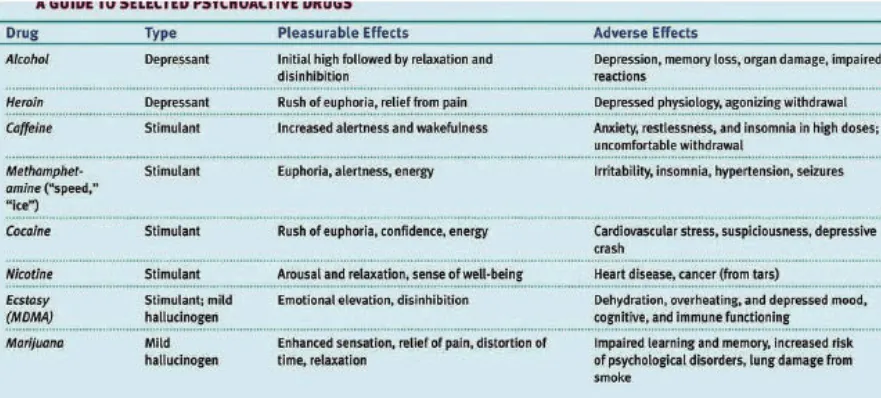
Brain 大脑
Brain Study Method 研究大脑的方法
- 事故 Accident: Gage’s case
- 前额叶会控制人的性格和情绪
- 病变 Lesion: Brain-split
- 早期治疗精神疾病 把左右脑分离 导致举动和常人不同
- Autopsy 验尸
- 通过 EEG Electroencephalogram 脑电图,观测脑电波
- EEG 只能得到大脑工作方式(Function) 但是无法获得结构(Structure) 一般用于 睡眠分析
- Magnetic Resonance Imaging (MRI) 核磁共振成像
- 不能推出大脑作用,只能看出结构
- Functional MRI (fMRI)
- 结合 Positron Emission Tomography(PET) 正电子发射断层扫描,获得血液流动情况
- 推断出大脑部位的不同作用
- Computerized Axial Tomography (CAT) 计算机轴向断层扫描
- 通过多个不同方向的 X 射线,组合形成最后截面成像
- 不仅能扫大脑,还能扫脊椎
Brain Structure 大脑结构
- 后脑(Hindbrain / Oldbrain)The oldest part of the brain to develop
in evolutionary terms
- 从进化角度,最先发展的
- 中脑(Midbrain)It responsible for visual and auditory reflexes and
integrates some types of sensory information and muscle movements
- 它负责视觉(Visual)和听觉反射(Auditory Reflex),并整合某些类型的 感觉信息 和 肌肉运动
- 前脑(Forebrain)Contains the limbic system or emotional center of
the brain. And cerebral cortex or the wrinkled outer laver of the brain
- 包含大脑的边缘系统(Limbic System)或情感中心(Emotional Center),和大脑皮层(Cerebral Cortex)
- 边缘系统(Limbic System)指包含海马体及杏仁体在内,支援多种功能例如情绪、行为及长期记忆的大脑结构。
Hindbrain 后脑
- Cerebellum 小脑
- 控制肌肉张力和平衡(Muscle Tone and Balance)
- 醉酒后被抑制 → 无法正常走路
- Medulla Oblongata 脑干
- 无意识(Involuntary)的动作(Essential Ac tivity)
- 心跳,呼吸,血压
- Reticular Activating System 网状结构
- 控制唤醒(Arousal)
- 受损会陷入深度昏迷(Deep Coma)
- Pons 脑桥,是脑干的一部分,脑桥对于睡眠具有调节和控制的作用。
- Corpus Callosum 胼胝体
- 连接大脑不同部分,将神经信息从一个大脑区域传递到另一个大脑区域
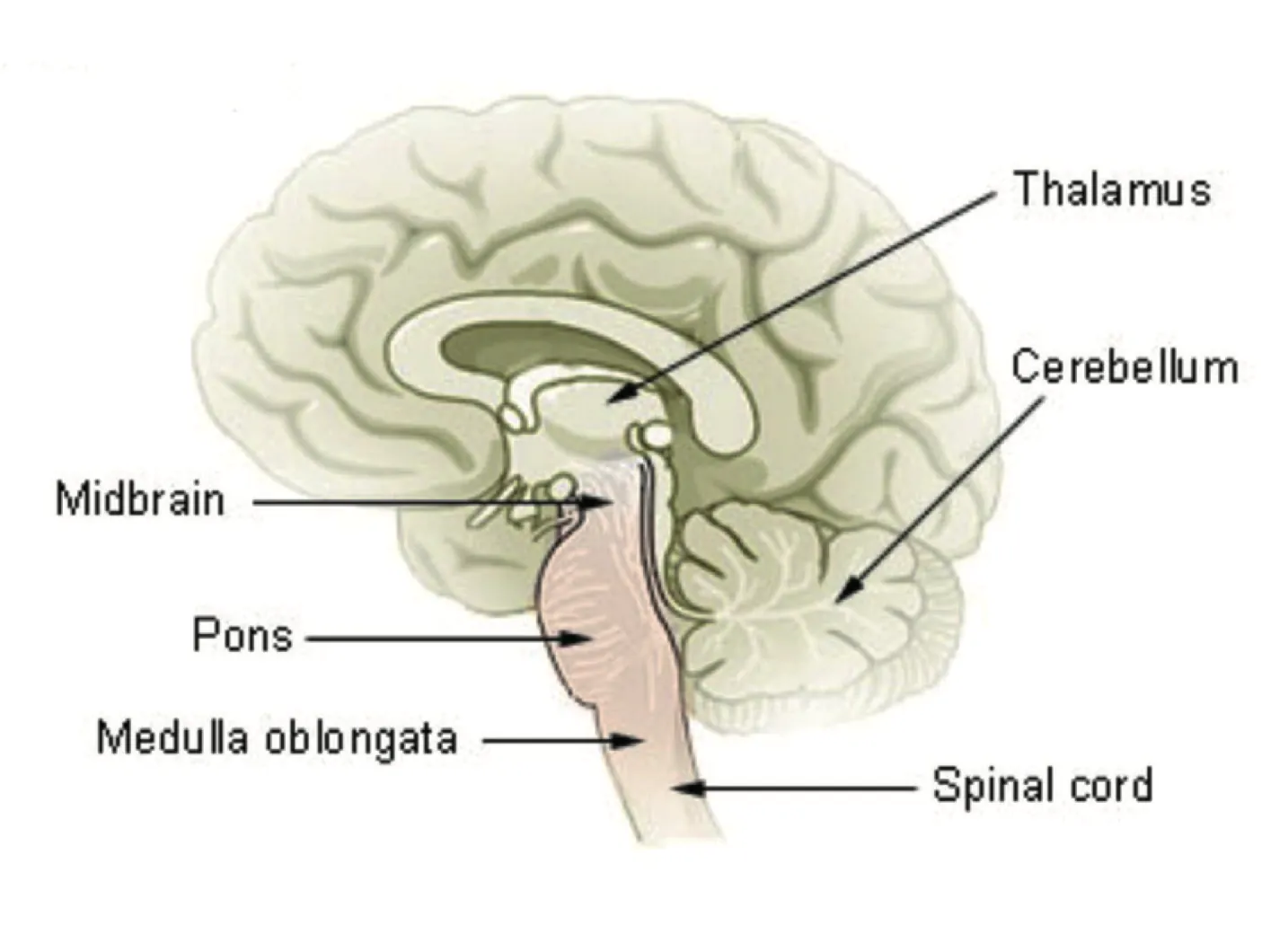
Midbrain 中脑
- Tectum (brains roof) and tecmentum (floor)
- 反应视觉听觉
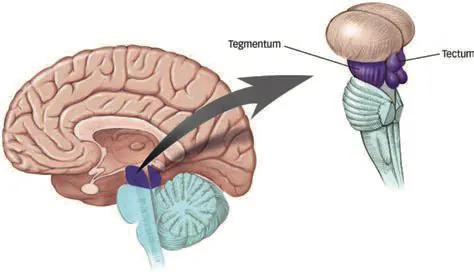
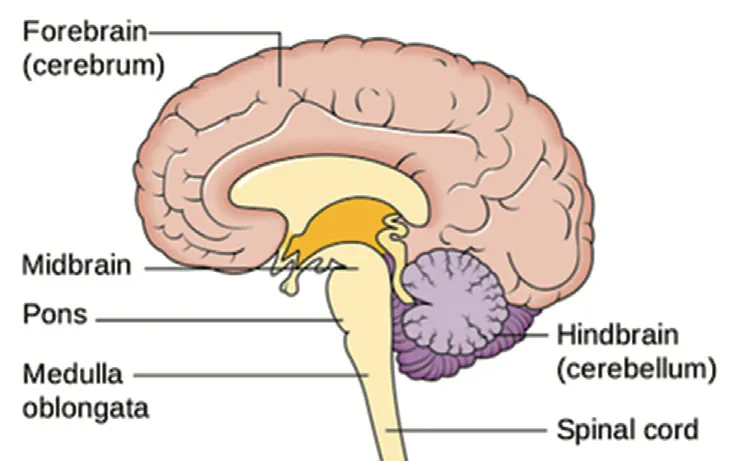
Forebrain 前脑
- Limbic System 边缘系统
- Thalamus 丘脑
- 传导感知 Sensory 信息,大脑需要 处理高级信息时需要经过 这里
- Hippocampus 海马体
- 记忆 Involved in processing and integrating memories
- 管控新的记忆 不是存储记忆(类似于通道)
- Amygdala 杏仁核
- Implicated In the expression of emotions especially anger and frustration
- 表达情绪,主要是负面情绪(愤怒与挫折)
- Hypothalamus 下丘脑
- Controls the temperature and water balance of the body, controls hunger, biological rhythms, and sex drives, and controls endocrine system
- 保持身体内部稳态
- 管理内分泌系统,控制身体的温度和水平衡,控制饥饿,生物节奏和性驱动,并控制内分泌系统
- Thalamus 丘脑
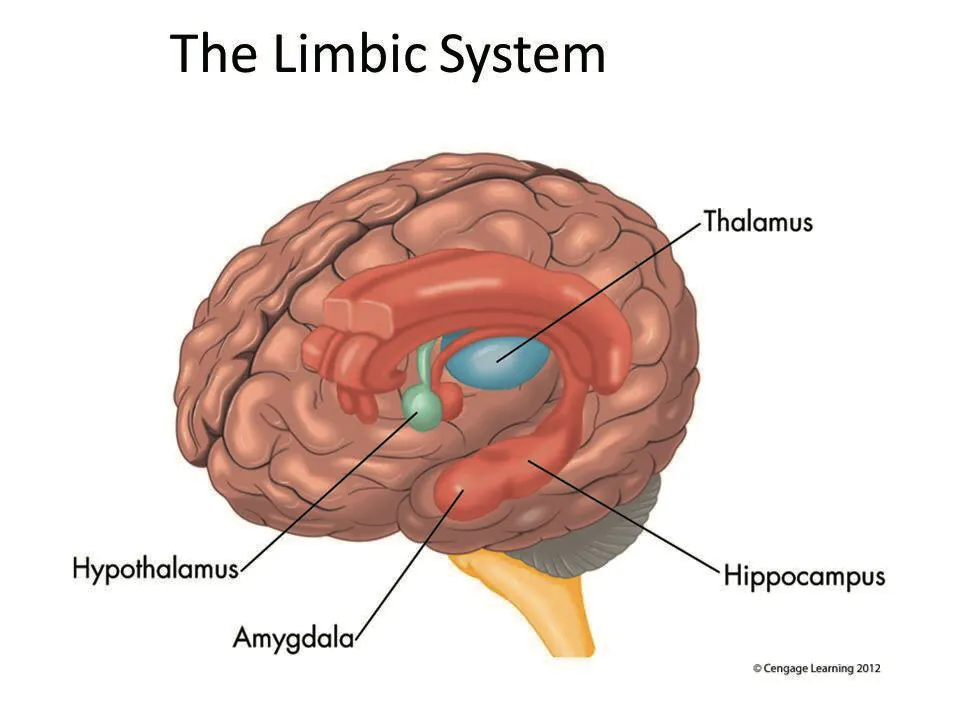
- Cerebral Cortex 大脑皮层
- Wrinkled Surface 褶皱
- 皱纹是为了增加大脑皮层面积
- Neurons are not yet connected when we are born
- 大脑在出生时 神经元是不够紧密连接的 需要后天连接
- Cortex Component 大脑皮层的组成部分
- Frontal Lobe 额叶
- Higher-level thought and reasoning
- 高级思想,性格,自我管理
- Parietal Lobe 顶叶
- Receives information about temperature, pressure, texture, and pain
- 体感信息,接收有关温度、压力、质地和疼痛的信息
- Somatosensory Cortex(感觉皮层): Responsible for receiving and processing sensory information from across the body
- Temporal Lobe 颞叶
- Process speech and appreciating music
- 说话与听觉
- Occipital Lobe 枕叶
- Process visual information
- 视觉
- Frontal Lobe 额叶
- Wrinkled Surface 褶皱
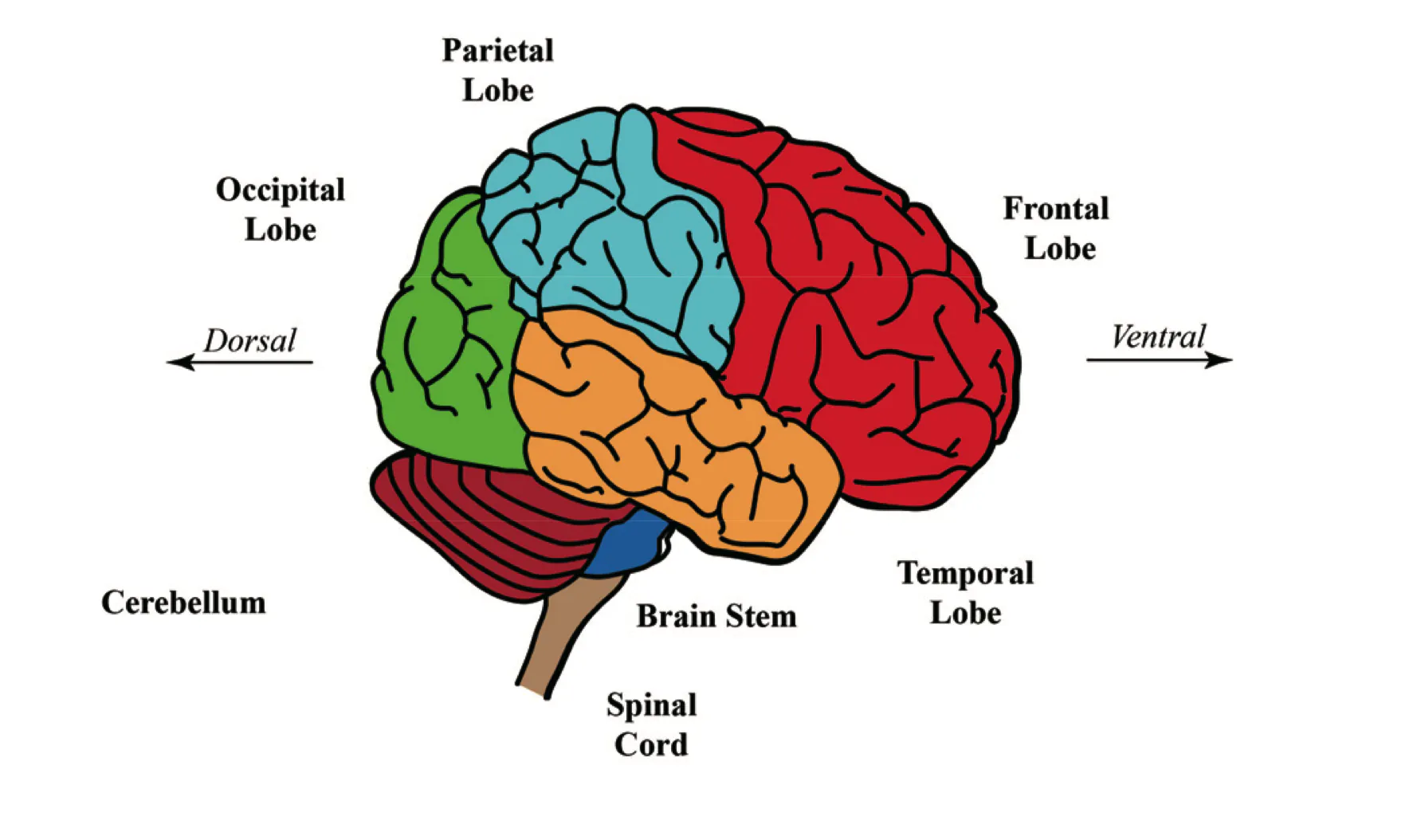
- Lateralization of Brain Function 分边处理
- 若左边接收,便右边处理,若右边接受,便左边处理
- Roger Sperry 实验
- 在切除左右脑连接的胼胝体(Corpus Callosum)时,两边无法交流
- 例如左眼看到的信息无法用语言表达(需要右脑处理)
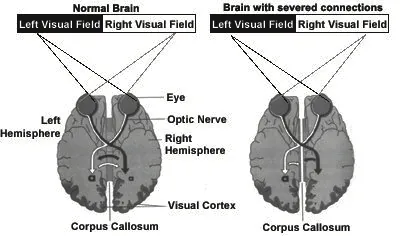
Brain Specific Area
- Broca’s area 布洛卡区 — 位于左额叶(Frontal Lobe)
- Frontal lobe on the left side of the brain controls the muscles involved in producing speech
- 控制说话的肌肉
- Wernicke’s area 韦尼克区 — 位于左颞叶(Temporal Lobe)
- Located in the temporal lobe on the left side of the brain
- Involved in comprehension of speech.
- 语言理解
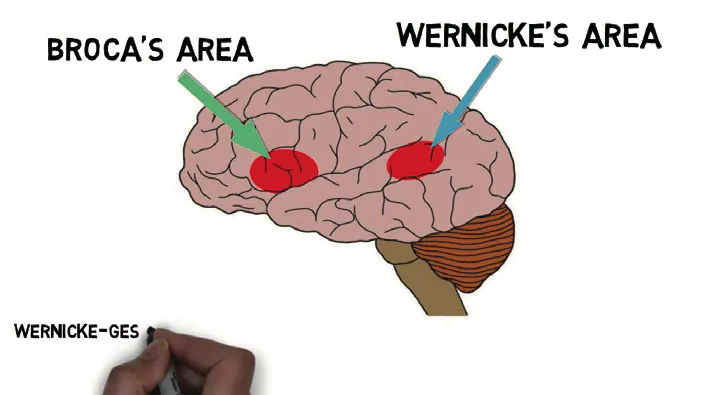
- 大脑分布有时因人而异,比如左撇子
Brain / Neuron Plasticity 神经元可塑性
- The ability of the brain to change throughout an individuals life
大脑结构并不是与生俱来 会根据发育而变化
- Long-term potentiation (LTP) is a persistent strengthening of synapses based on recent patterns of activity
- 如果一直刺激某个神经元,那么突触(两个神经元连接的缝隙)就会越加活跃,可以学习
- 经验可以重塑大脑 (某些皮层被放大) Experience can sculpt features of brain structures
- 伤害可以导致神经重组 Neural Reorganization
- 可能诞生新的神经元
- 大脑重塑有极限
- 年龄增大,重塑能力下降
- Michael Gazzaniga – 认知神经科学之父 Father of Cognitive Neuroscience
Consciousness 意识
- The awareness that we have of ourselves, our internal states, and
the environment
- 自我对周围环境的感知
- William James — stream of thought
- 意识流
- Robert Sternberg — a mental reality that we create in order to adapt
to the world
- 我们为了适应世界而创造的一种心理现实
Level of Consciousness 意识的等级
- Preconscious Level — contains information that is
available to consciousness but is not always in consciousness
(automatic behaviors) 自动行为
- 因为习惯或者熟练对在处理某个事物时不需要多加思考,例如骑自行车的过程中不会去思考如何蹬踏板
- 如果想要意识,便可以意识到
- Non-conscious Level — Body processes controlled by
your mind that we are not usually (or ever aware of.
(involuntary behaviors) 非自愿行为
- 呼吸 心跳
- Subconscious Level — Information that we are no
consciously aware of but we know must exist due to behavior.
(priming mere exposure effect)
- 自己没有意识到,但是后期通过某些行为意识到
- Priming 启动效应,在路边遇到广告牌上的单词时没有注意,但是当在书本里背到这个单词时就回想起了在路上的经历,从而背这个单词比其他更加轻松
- Exposure 曝光效应,人们会单纯因为自己熟悉某个事物而产生好感
- Unconscious level 无意识 events and feelings are
unacceptable to our conscious mind and are repressed into the
unconscious mind
- 例如人们过去的创伤虽然被忘记 但是其实他在无时无刻控制我们的举动 和 行为模式
Sleep 睡眠
- Sleep: Alternative state of consciousness
- Sleep onset: the stage between wakefulness and
sleep
- 介于即将睡着的状态
- Use EEG 脑电图 to study sleep cycle
- Circadian Rhythm 节律
- Suprachiasmatic Nucleus 视交叉上核(SCN),负责昼夜节律
- Somnambulism 梦游
- Delusions 妄想
- Hallucinations 幻觉
- Hypnagogic 入睡前发生的
- REM Rebound 是睡眠剥夺后发生的快速眼动睡眠的频率和深度的延长和增加。当人们被阻止经历REM时,他们花费比平常更少的时间来达到REM状态。当人们无法获得足够量的REM睡眠时,获得REM睡眠的压力就会增加。
Cycle of Sleep 睡眠周期
2.7.5.6 REM Sleep 快速眼动期 – β – 做梦,容易惊醒
- Stage 1 刚进入睡眠 脑波变化: \(\beta \text{ wave} \to \alpha \text{ wave} \to
\theta \text{ wave}\)
- Awake 醒着 — \(\beta \text{ wave}\) 低 Voltage, 高 Frequency
- Drowsy 困 — \(\alpha \text{ wave}\) 高 Voltage, 低 Frequency
- 第一阶段 — \(\theta \text{ wave}\) — \(\pu{10 min}\)
- Stage 2 Sleep Spindles (These spindles are
occasionally broken up by K complexes, Which are large, slow
waves)
- 混合 + Sleep Spindle — \(\pu{20 min}\)
- Stage 3 / 4 深度睡眠
- 慢波睡眠 — \(\delta \text{ wave}\) — \(\pu{40 min}\)
- 身体进行修复的阶段
- 如果在这个阶段频繁被打扰 会严重影响日常生活
- REM Stage 快速眼动时期 (Rapid Eye Movement):
- Complicate in dream 出现梦,容易被惊醒
- 呈现和醒着一样的 \(\beta \text{ wave}\),脑电波活跃
- 完整睡眠周期大约为 1.5 h
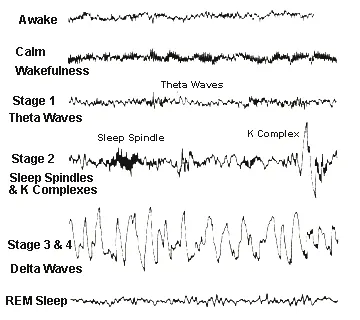
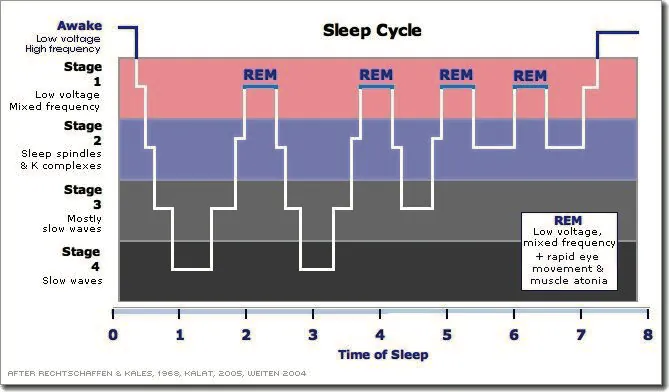
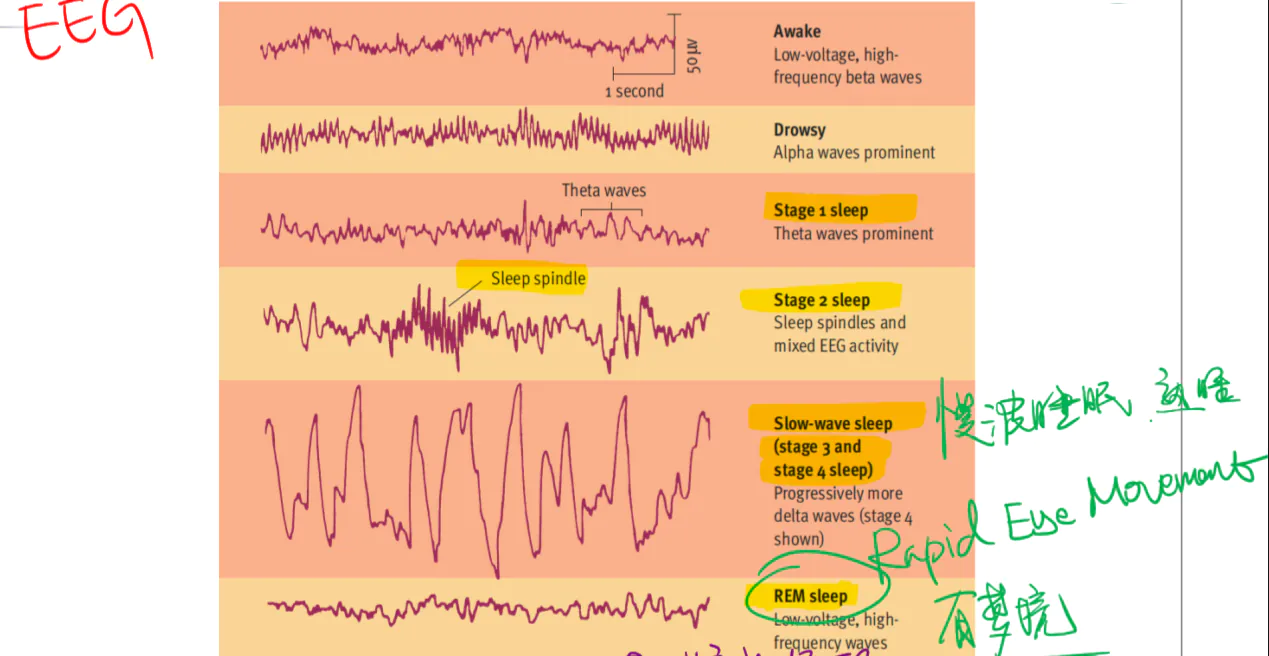
Sleep Disorder 睡眠疾病
- Insomnia 失眠: People will have persistent problems
getting to sleep or staying asleep at night. The most common sleep
disorder
- 难以入睡,或者 无法进入深度睡眠
- Narcolepsy 嗜睡症: Narcoleptics suffer from periods
of intense sleepiness and may fall asleep at unpredictable and
inappropriate times (directly into REM stage); occurs far more rarely
- 无法控制睡眠(突然睡着)
- Sleep apnea 睡眠呼吸综合征: Stop breathing for
short periods of time during the night; as common as insomnia
- 睡眠过程中突然暂停呼吸
- 间断式的呼噜声,可能致命
- 多发于中年
- Night terrors 梦惊: Sit up in bed in the middle of
the night and scream and move around room
- 睡眠过程中 突然惊醒 甚至哭喊
- 多发于低龄
- Nightmare 噩梦: An elaborate dream sequence
produces a high level of anxiety of fear for the dreamer
- 多频次的真实的恐怖梦境
- Restless Leg Syndrome 下肢不灵
- Nocturnal Leg Cramps 夜间腿部痉挛
- Circadian Rhythm Disorders 节律混乱
- 可以用褪黑素 (Melatonin) 调节
- Enuresis 遗尿症
Dream 梦
- Dream Interpretation — Sigmund Freud
认为梦分为两个部分
- Latent Content 被压抑的情绪和记忆(Unconscious Mind)在梦境中出现,梦隐含的深意
- Manifest Content 梦呈现的表象
Dream Theories 梦的理论
- The Activation-synthesis Theory : Dreams are merely
the brains reaction to random biological processes that occur during
sleep
- 梦是生理刺激的反应
- 睡觉时在下雨 因此梦到瀑布
- The Information-processing Theory: The brain is
dealing with daily stress and information during REM dreams. The
function of REM may be to integrate the information processed during the
day into our memories
- 在日常的一些未处理的信息在梦中处理 日有所思夜有所梦
- 在睡觉后前一天记忆的内容更加清晰了
- The Problem-solving Theory: Dreams provide a chance
for the mind to work out issues that occupy its attention during waking
hours
- 在日常中没有解决的问题 在梦中突然发现解决方法
Unit 3: Sensation and Perception
- Sensation: detecting stimuli from
the body or surroundings
- 对于信息和刺激的探测
- Perception: interpreting and
organizing sensations into meaningful patterns
- 对信息的更高级的处理
Basic Principle of Sensory Transduction
Absolute Threshold 绝对阈值
- Absolute Threshold 绝对阈值,the minimum amount of stimulation one can detect through a given sense 50% of the time
- 想要感受到刺激的最小的量,识别成功率 50% 以上
- e.g. 熊的照片要在一定大小以上 才能认出是熊
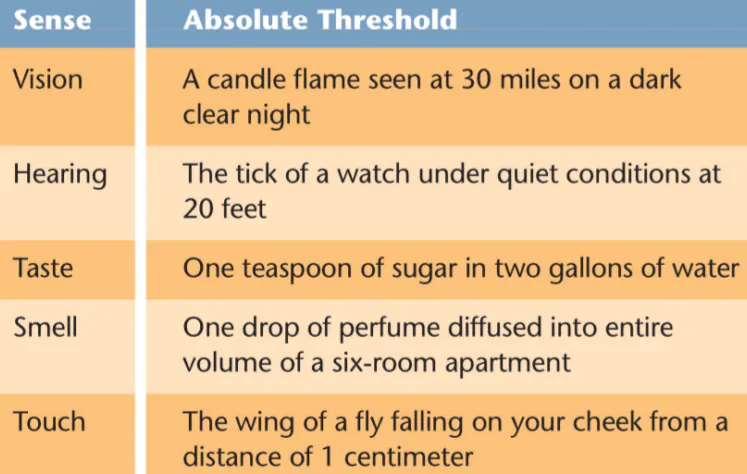
Noticeable / Difference Threshold 差别阈值
- Just Noticeable Differences (JND) 感受得到的最小变化程度
- Weber’s Law 韦伯定律
- Computes the Just Noticeable Difference (JND)
- It’s always a constant % NOT a constant amount
(一般计算出变化率而不是差值)
- e.g. 两盏灯必须亮度差异必须要大于8%才能感受出差异
- JND 和当前的刺激之比为定值。即,当前刺激越大,JND越大,当前刺激越小,JND越小。 \[ K(\text{constant}) = \frac{\Delta I}{I} \]
Signal Detection Theory 信号感知理论
- e.g. 雷达探测:如果目标(Signal)真实存在并且被探测 那么就是(Hit) ; 如果目标不存在 但是雷达显示被探测 那么就是误判(False Alarm)
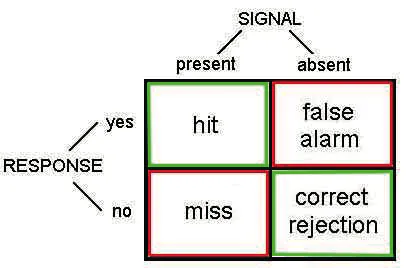
Sensory Habituation 感知习惯
- Habituation,Tendency of sensory receptors to respond less and less to constant stimulation
- 对于周围环境的习惯
- 如果我们持续接收的同一个刺激,那么我们的反应就会越不明显
- 我们会逐渐忽略长时间持续的噪音
- 一件事做多了就会无聊
Sensory Adaption 感知适应
- Sensory adaptation is a change over time in the responsiveness of the sensory system to a constant stimulus
- 如果我们持续接收的同一个刺激,我们会逐渐适应
- 刚进入黑屋子时因为光线急剧变化看不到事物,但是当在黑屋子呆久后瞳孔增大就会看清屋内
Synesthesia 联觉
- 本来是一种通道的刺激能引起该通道的感觉,现在还是这种刺激却同时引起了另一种通道的感觉,这种现象叫联觉。
- 例如,看到红色会觉得温暖,看到蓝色会觉得清凉,听到节奏鲜明的音乐会觉得灯光也和音乐节奏一样在闪动。
Basics of Perception 感知
Bottom-Up 从下往上理解
- Feature Analysis 从特征开始感知
- 不熟的人:先看特征 → 想是谁
- We use the features on the object itself to build a
perception
- 吃柠檬时会从酸味开始感知
- Takes longer than top-down but is more accurate 花更长时间 但是更加准确
Gestalt Principle 格式塔原则
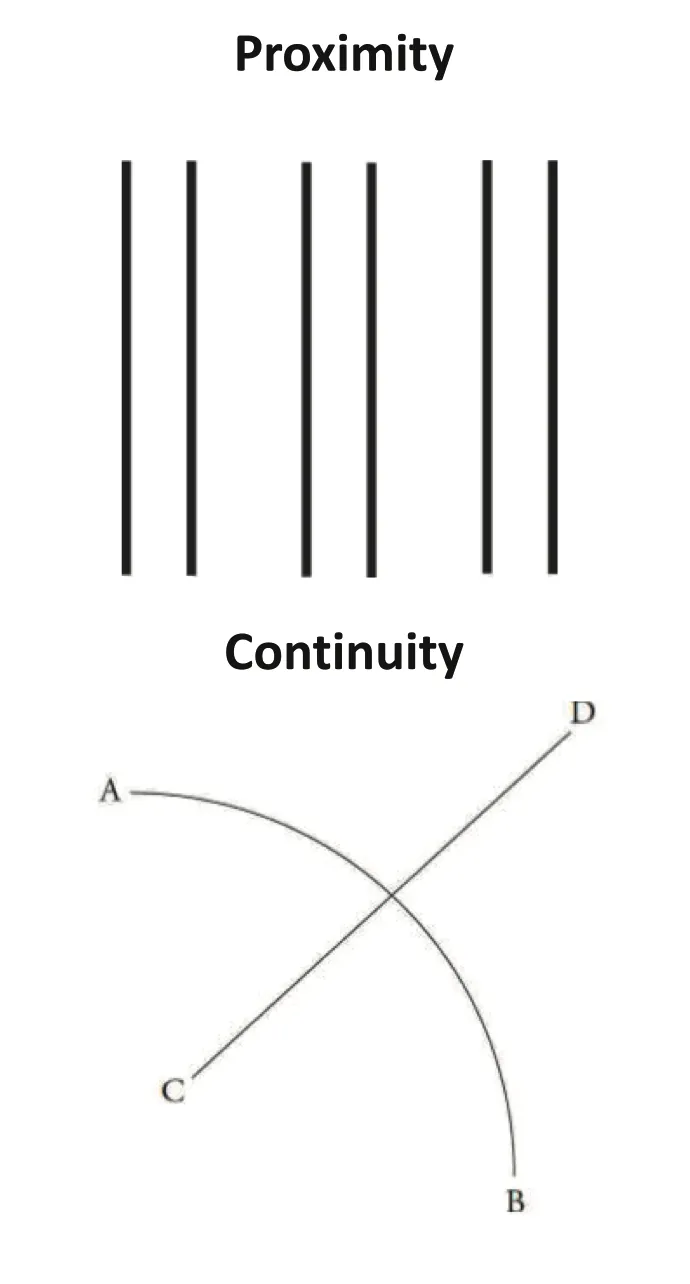
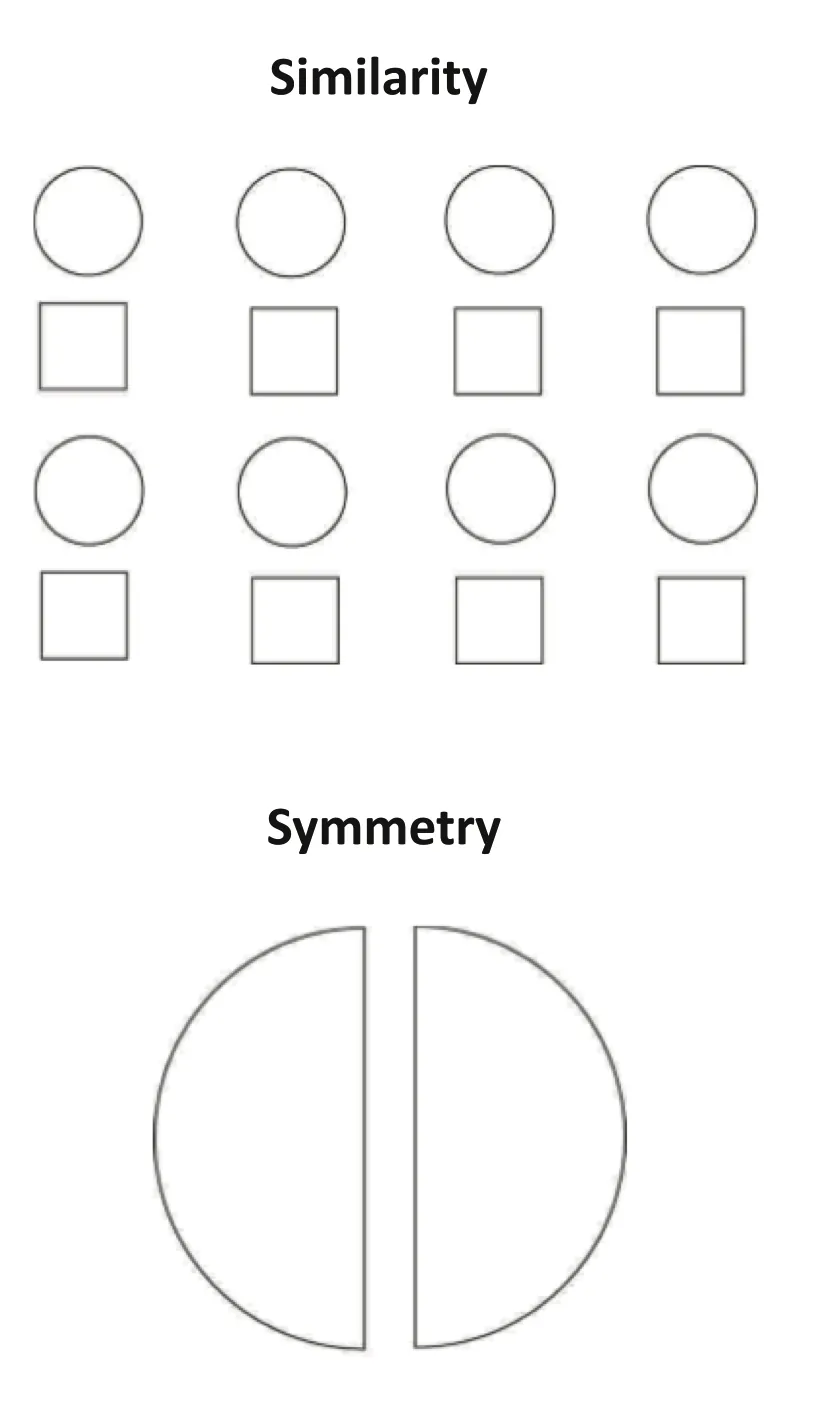
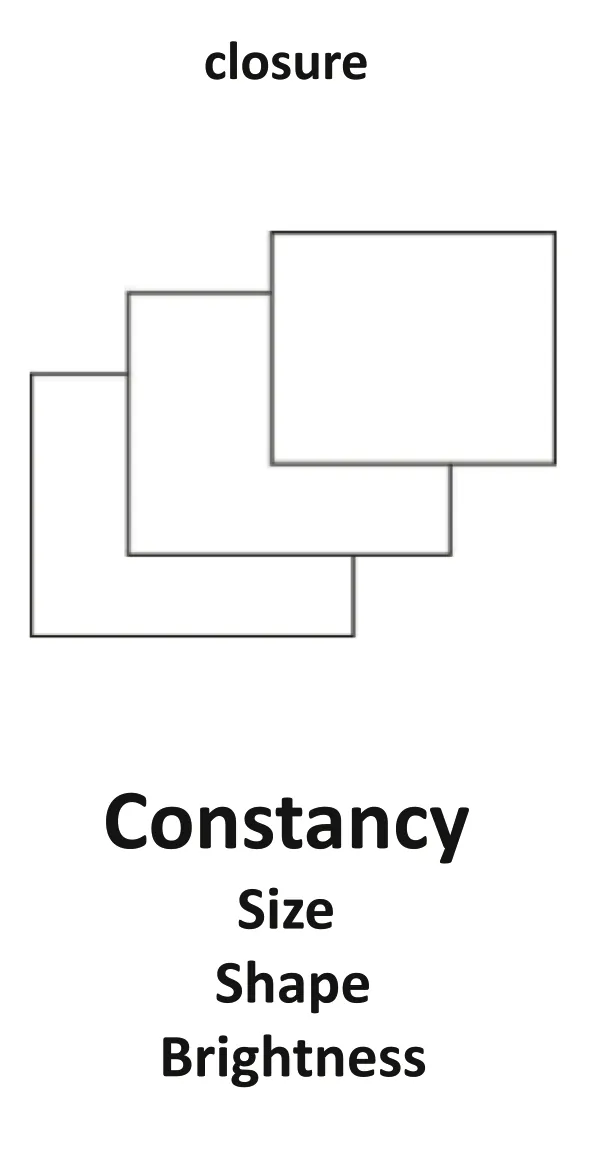
- 描述我们在处理信息时对信息的倾向性
- Proximity — 临近性原则,上图我们一般会把6条线归位比较贴近的3组线
- Continuity — 连续性原则,把断开看作连续,有指向性的东西,会被认为是一个整体
- Similarity — 相似性原则,把相似的归为一类
- Symmetry — 对称性原则,把对称的归位,比如把两个半圆看成整个园
- Closure — 封闭性原则,被挡住时,脑补整个图像
Common Region 相同组域
- 虽然三个圆角矩形里面的东西不一样,但是我们感受到的就是三个圆角矩形。至于里面的东西,他们都属于外面的圆角矩形 (common region),所以每个圆角矩形没理解成一个整体

Simplicity 简洁性原则
- 趋向于去用最简单方法理解
- 感受到的是一个三角形+长方形
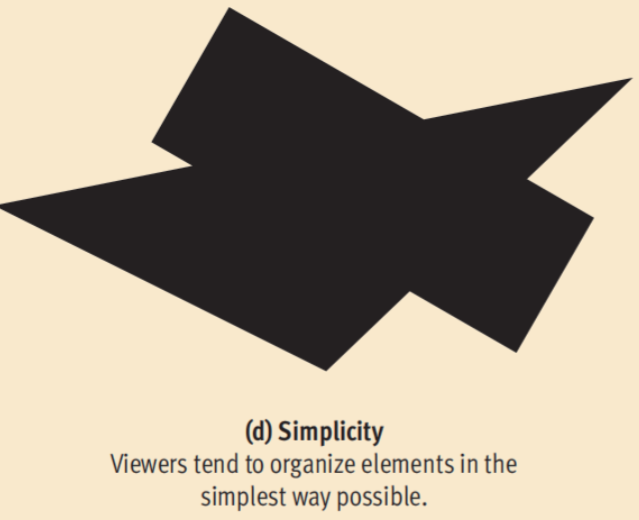
Constancies 恒常性
- Size (Distance), Shape, Brightness 变了,但还是认知为同一个东西
Top-Down 从上往下理解
- Experience Based 基于经验和直觉
- 熟人:整体有个感觉,脑内先猜个结果出来 → 看这个人的细节,检验猜想
- We perceive by filling in the gaps in what we sense
- I_ant ch_co _ate ic_cr_am
- 如果你看到许多戴眼镜的老人,你更容易处理一张老人的照片
- Based on our experiences, schemas and expectations 更具以往知识和经验对事物进行理解
Perceptual Set 知觉定式
- Perceptual Set 知觉定式 is a tendency to perceive
or notice some aspects of the available sensory data
and ignore others. (Based on expectation)
- 我们看待事物时会有一个预测和预期(Prediction and Expectation)
- e.g. 乒乓球拍只能打乒乓球
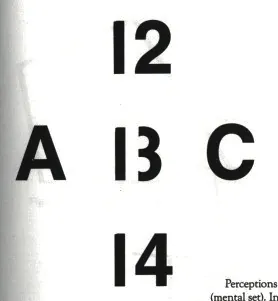
- Context Effect 上下文效应 is the context
(environmental factors) that surrounds an event effects how an event is
perceived and remembered
- 中文的序顺不响影读阅

Illusion 错觉
- Ames Room Experiment
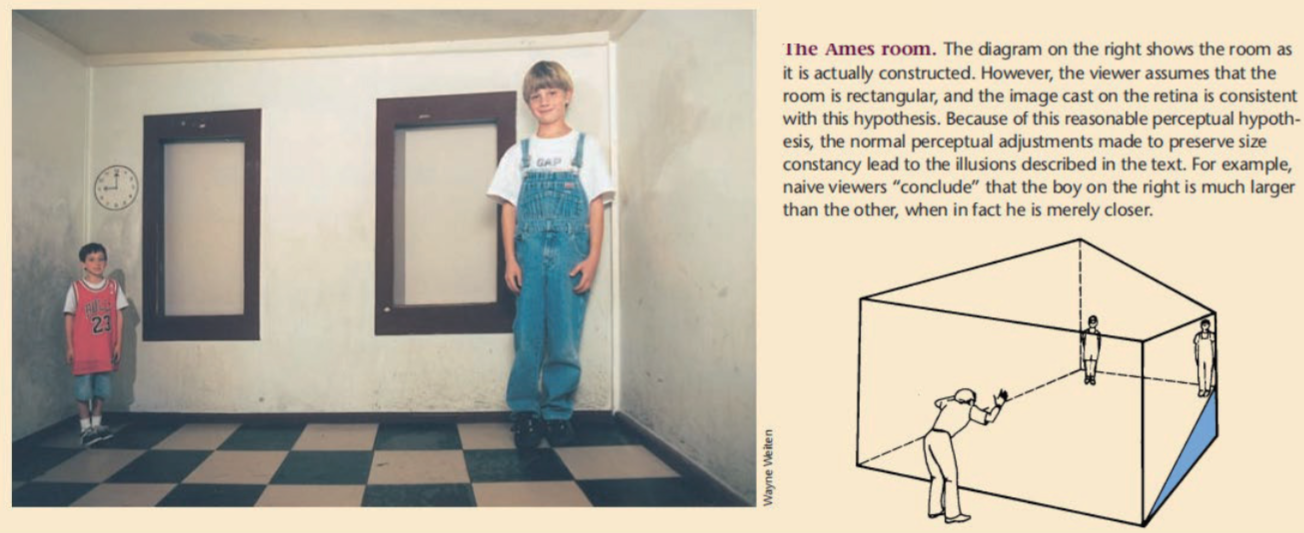
- Illusory Correlation
- 两件事好像有联系,实际上屁关系没有。举个例子:背单词瞎联想。
- Subliminal Stimuli 阈下知觉
- 可以激活 Receptor Cells, 但是感知不到 (not strong enough for people to be consciously aware of them)
Cocktail Party Effect 鸡尾酒会效应
- 选择性收听,在噪音中都可以谈话
Sensory Transduction 感觉传导
- 将信号转化为神经冲动(Neural Impulses)
- 信号先经过丘脑(Thalamus),最后再到各个脑区
- Vision
- Audition
- Taste
- Smell
- Touch
Vision 视觉
- 我们最主要的感觉(视觉捕捉)
- 眼就像相机(需要光)
Structure of Eye 眼的结构
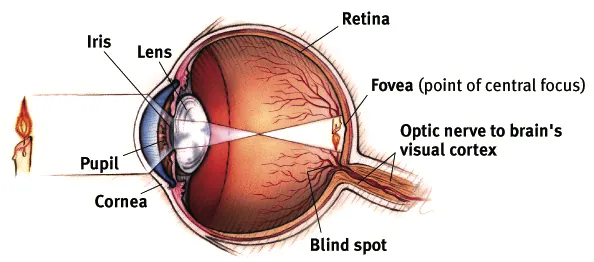
- Iris 虹膜,控制进光量 — 控制瞳孔大小(可着色) Regulates the amount of light going into the eye colored part).
- Pupil 瞳孔,被虹膜包围 — 进光口 Black opening where light enters
- Lens 晶状体,凸透镜结构 — 聚焦 Focuses light on the retina.
- Retina 视网膜 — Has layers of sensory cells
(Photoreceptor):
- Cones 视锥细胞— (6 million) for color and
daylight vision. Highly concentrated near the fovea
(back center of the eye)
- 集中在视网膜中央,感知日光和色彩,弱光和明暗的感知不如视杆细胞敏感
- Rods 视杆细胞— (120 million) for peripheral and
night vision located along the sides of the retina
- 集中在视网膜周围 负责余光 和 黑暗环境中的视觉,暗的环境也敏感,对光的变化敏感
- Fovea 中央凹
- 只有视锥,没有视杆
- 视觉最敏锐
- Cones 视锥细胞— (6 million) for color and
daylight vision. Highly concentrated near the fovea
(back center of the eye)
- 顺序为:光纤从角膜(Cornea)进入眼中,穿过瞳孔(Pupil),虹膜(Iris)打开,接受光线直至晶状体(Lens),然后进入视网膜(Retina)
- Blind Spot 视觉盲点 / Optic Disc 视盘
- A blind spot, scotoma, is an obscuration of the visual field
- 上下神经树交汇区域 无法收集像
- 大脑会自动补全盲点,因此我们实际中不会感知到一个看不到的点
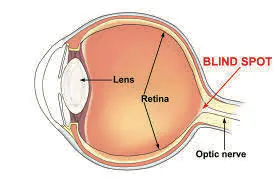
Vision in Brain 大脑视觉
- Goes to the Visual Cortex located in the Occipital Lobe of the Cerebral Cortex
We have specific cells that see the lines, motion, curves and other features. They are called feature detector cells (Discovered by Hubel and Wiesel
- 视觉传导过程: Retina 视网膜 → Bipolar Neuron Cell 双极神经元细胞 → Ganglion Cell (Optic Nerve) 神经节细胞 → Thalamus → Occipital Lobe → Visual Detectors
- Goes to the Visual Cortex located in the Occipital Lobe of the Cerebral Cortex
- We have specific cells that see the lines, motion, curves and other features. They are called feature detector cells (Discovered by Hubel and Wiesel)
- 我们有特定的细胞,可以看到线条、运动、曲线和其他特征。它们被称为特征检测细胞
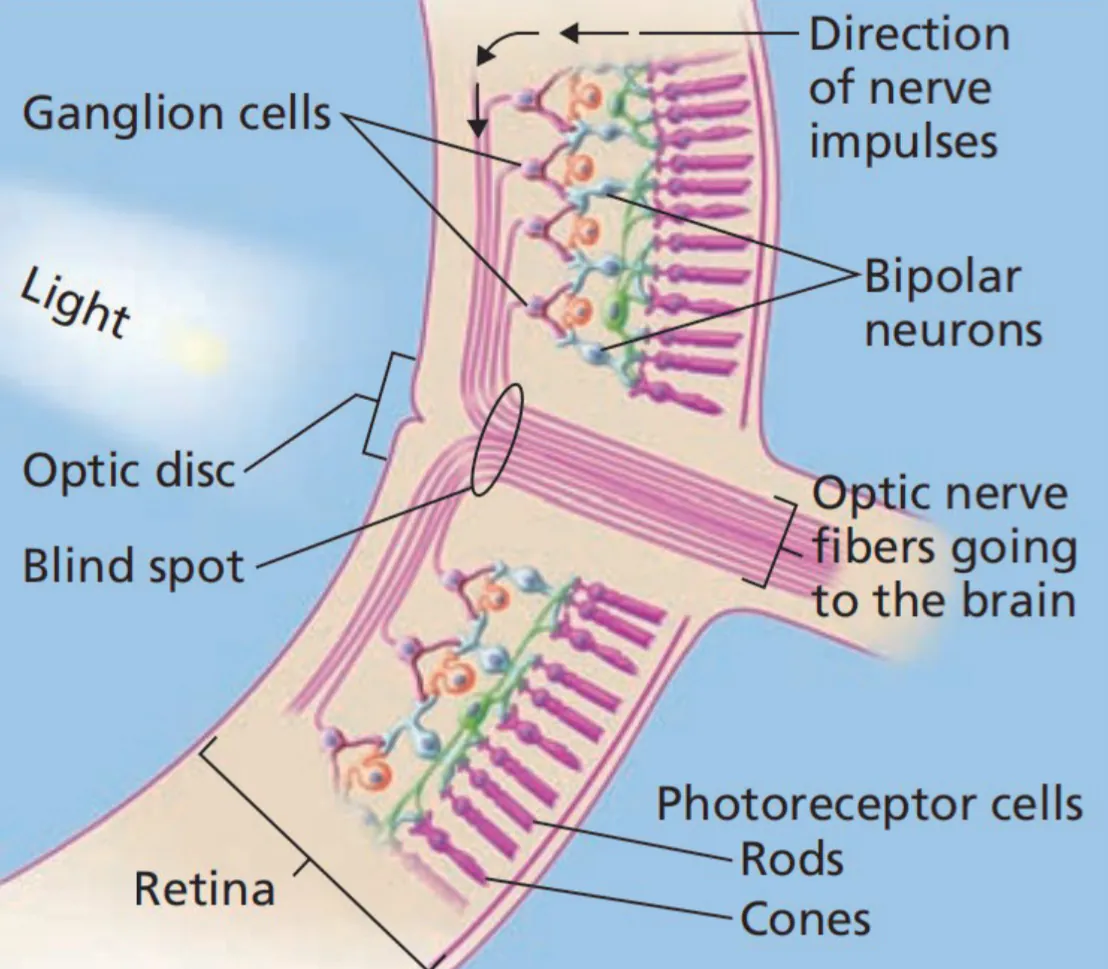
- Parallel Processing 同步处理
- The processing of several aspects of a problem simultaneously
- 大脑会同时处理图像中的各种特征
- Image Theory 1: Three types of Cones 三原色理论
- Red, Green, Blue 三种视锥细胞
- These three types of cones can make millions of combinations of colors
- Does not explain afterimages or color blindness
well
- Afterimage 后像
- 正后像:刺激过短,有惯性,比如烟花的闪烁
- 负后像:在长时间看完一个图像后 眼睛会有残影
- Afterimage 后像
- 不能很好地解释负后像和色盲
- Image Theory 2: Hering’s opponent-process theory
- The sensory receptors come in pairs
颜色是成对出现的,一个 激活 Stimulated ,另一个 抑制
Inhibited
- Red / Green
- Yellow / Blue
- Black / White
- If one color is stimulated the other is inhibited 一种颜色被激活 另一种颜色被抑制
- The sensory receptors come in pairs
颜色是成对出现的,一个 激活 Stimulated ,另一个 抑制
Inhibited
Perceived motion 运动知觉
- Stroboscopic Effect 频闪效应 a visual phenomenon
caused by aliasing that occurs when continuous motion is represented by
a series of short or instantaneous samples
- 动画片
- Phi phenomenon Phi 现象 the optical illusion of
perceiving a series of still images, when viewed in rapid succession, as
continuous motion
- 一排彩灯交替亮起 我们会认为彩灯在动
- Autokinetic effect 似动效应 a stationary, small
point of light in an otherwise dark or featureless environment appears
to move
- 如果在暗处有一束小光,我们有时候会感觉它在运动
Monocular cues 单眼线索
- 只用单眼就可以处理的图像
- Linear Perspective 直线透视
- Interposition / Occlusion - 我们通过遮挡来感知深度
- Relative Size 近大远小
- Textures 纹路越进越清楚
- Aerial Perspective 近的清晰 远的模糊
- Motion Parallax 近快远慢
- Relative Clarity 近清远糊
- Motion Parallax 运动视差,近快远慢,近反远正
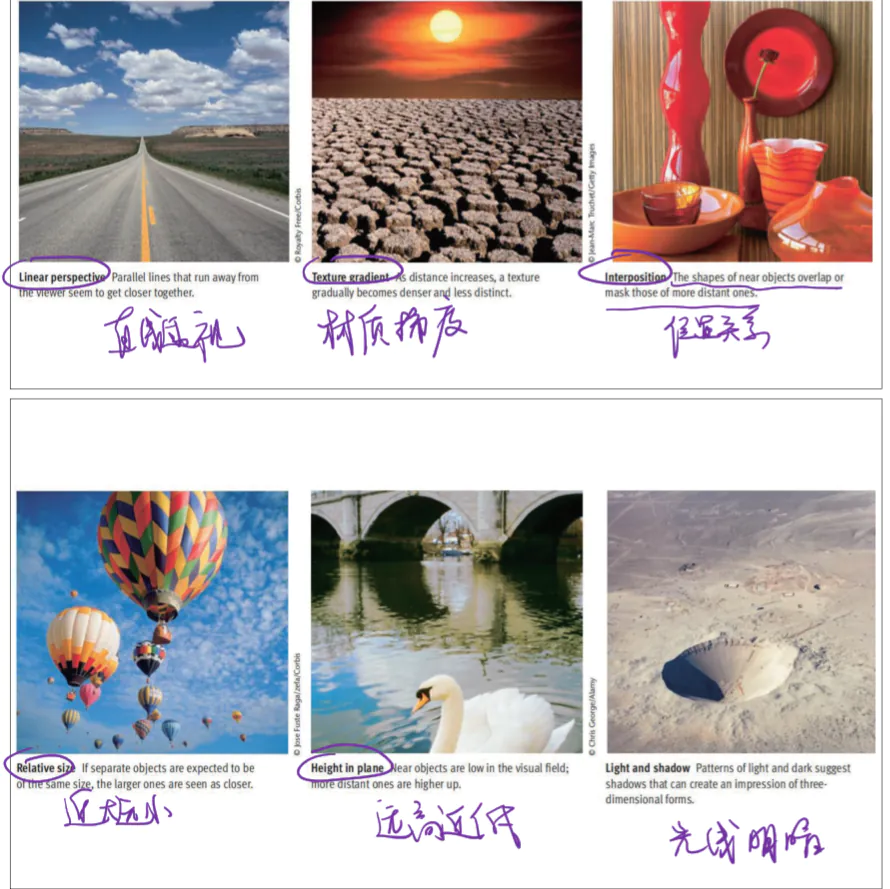
Binocular Cues 双眼线索
- 需要双眼才能感知的图像
- Stereopsis 立体视觉 (3D) / Retinal Disparity 双眼视差
- 由于双眼看到的角度不同 经过大脑处理出现景深
- Retinal convergence 视网膜收敛 / Binocular Convergence 双眼辐合
- When looking at an object, the greater the eye inward strain, the closer the object
- 看的物体越近,两只眼睛会靠的越近(斗鸡眼)
Depth Perception 深度感觉
- Visual Cliff 视觉悬崖 (Experiment)
- 如图场景中,婴儿拒绝爬过玻璃,意味着深度感知是天生的
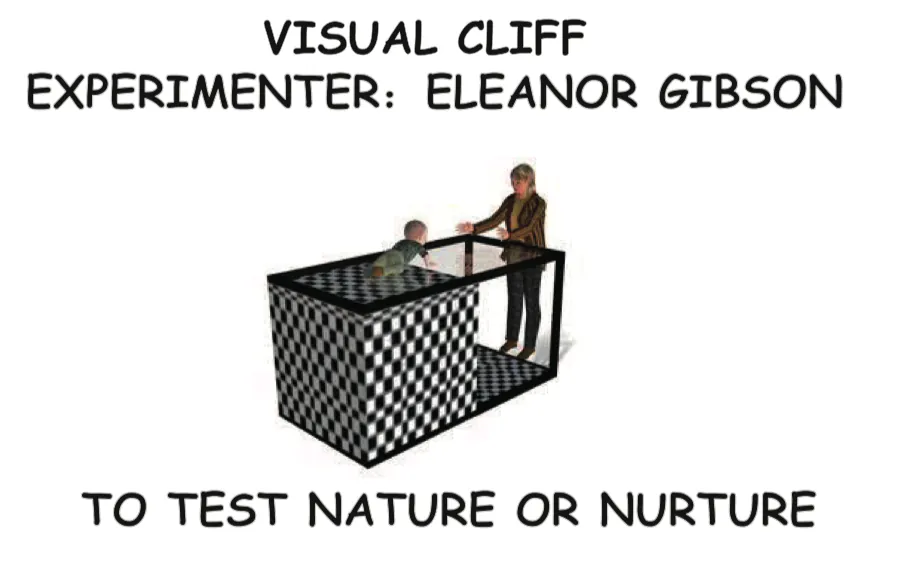
Muller-Lyer Illusion 错觉
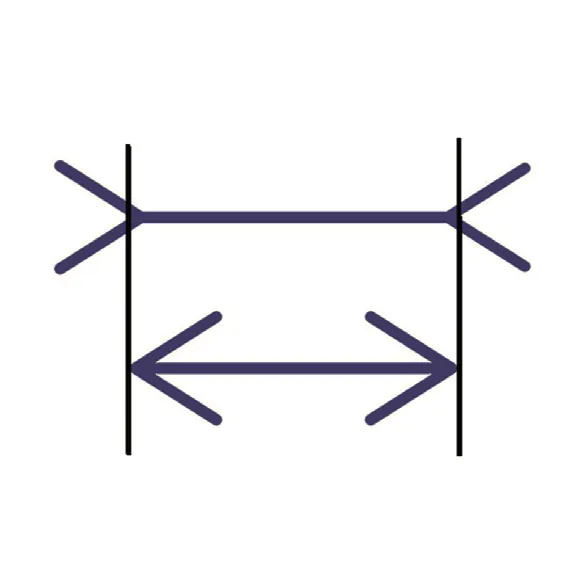
Attention 注意力
- Attention 注意力: The processing through cognition of a select portion of the massive amount of information incoming from the senses and contained in memory
- Selective Attention 选择性注意: When we try to
attend to one thing while ignoring another
- Cocktail Party Phenomenon: 在嘈杂的舞会中我们可有能力听清楚某个对话
- Divided Attention 我们拥有多事物处理能力: Trying to focus on more than one task at the same time
- Theories of Attention: Why we focus on something?
- Filter Theories 我们有能力过滤不必要信息: Propose that stimuli must pass through some form of screen or filter to enter into attention
- Attentional Resources Theory 我们集中精力是有限的 : Posit that we have only a fixed amount of attention and this resource can be divided up as is required in a given situation
Auditory Sensation and Perception 听觉与知觉
Audition 听觉
Outer / External Ear 外耳: Pinna / Auricle 耳廓, Ear Canal 耳道
Middle Ear: Eardrum 鼓膜,Chamber between eardrum and cochlea containing three tiny bones (hammer, anvil, stirrup) that concentrate the vibrations of the eardrum on the cochlea s oval window. 鼓膜,位于鼓膜和耳蜗之间的腔室,含有三块小骨头(听小骨 Ossicle)(锤骨、砧骨及镫骨),将鼓膜的振动集中在耳蜗的卵圆窗上。
Inner Ear 内耳: Innermost part of the ear, containing the cochlea, semicircular canals, and vestibular sacs. 耳朵的最内侧,包含耳蜗、半规管和前庭囊。
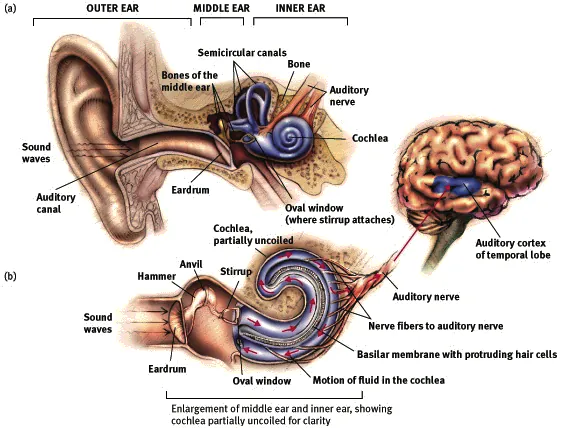
Inner Ear 内耳
- Cochlea 耳蜗: coiled, bony, fluid-filled tube in the inner ear through which sound waves trigger nerve impulses
- Basilar Membrane-the base for hearing sensory cells, hair cells. 内耳中盘绕的、骨质的、充满液体的管道,声波通过它引发神经冲动。
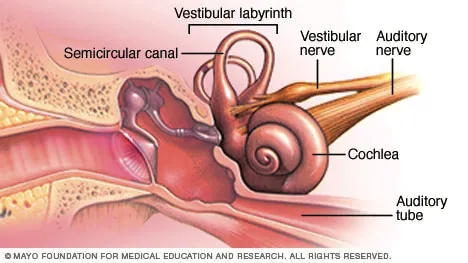
Sound Waves & Transduction in the Ear 声波在耳中的传导
- Eardrum 鼓膜 → Hammer, Anvil, Sitrupp 听小骨 → Basilar Membrane 震动基底膜 → Hair Cell 听毛细胞 / 震动基底膜 → Thalamus 丘脑 → Auditory Cortex 听觉皮层
- Receptor: 震动基底膜 (Basilar Membrane) 上的听毛细胞 (Hair Cell)
- FRQ Overall Process:
- Sound waves hit the eardrum, the bones of the middle ear (hammer anvil, stirrup)
- Then the fluid filled cochlea vibrates
- Everything is just vibrating
- Inside the cochlea is the basilar membrane
- On the basilar membrane there are hair cells
- When the hair cells vibrate they turn vibrations into neural impulses (organ of Corti)
- Neural impulse goes up the auditory nerve, then to thalamus, to the auditory cortex (temporal lobe)
- 声波撞击鼓膜,中耳的听小骨
- 然后充满液体的耳蜗就会振动
- 一切都在振动
- 耳蜗内是基底膜 BM
- 基底膜上有毛细胞 HC
- 当毛细胞振动时,它们将振动变成神经脉冲(Corti 器官)。
- 神经冲动沿着听觉神经向上,然后到丘脑,再到听觉皮层(颞叶)。
- Frequency 频率: the number of complete wavelengths that pass through point at a given time. # of wavelengths determine the pitch. 长波频率低,短波频率高。
Place Theory 位置理论
- 基底膜的不同位置上的神经细胞对应了不同音高 (Pitch) 的接收
- Hairs along different places in the cochlea vibrate when there are different pitches
- So some hairs vibrate when there are high pitches and others vibrate when there are low pitches
Frequency Theory 频率理论 (Theory of Telephone)
- 整个基底膜都是振动的,不同的声音频率 (Frequency) 对应着听到的不同音高 (Pitch)
- All the hairs vibrate but at different speeds
- The rate of the nerve impulses traveling up the auditory nerve matches the frequency of a tone
Neural Volleying Theory 神经齐射理论
由韦弗尔提出。认为当声音频率低于400Hz时,听神经个别纤维的发放频率是和声音频率对应的(频率理论)。声音频率提高,个别神经纤维无法对它们单独作出反应。在这种情况下,神经纤维将按齐射原则发生作用。个别纤维具有较低的发放频率,它们联合“齐射”,就可以反应频率较高的声音。用齐射原则可以对5000Hz以下的声音进行频率分析。频率超过5000Hz,位置理论是对频率进行编码的唯一基础。 ### Location of Sounds 声音的位置
Sounds that reach one ear sooner than the other ear cause us to ocalize the sound. Its also louder for one ear
离声源近的耳朵会更快的收到声音,双耳效应
Hearing Defect 听觉损伤
- Older people tend to hear low frequencies well but suffer hearing loss when listening for high frequencies
- 老人在不同频率上的听觉会损伤,尤其是高频部分
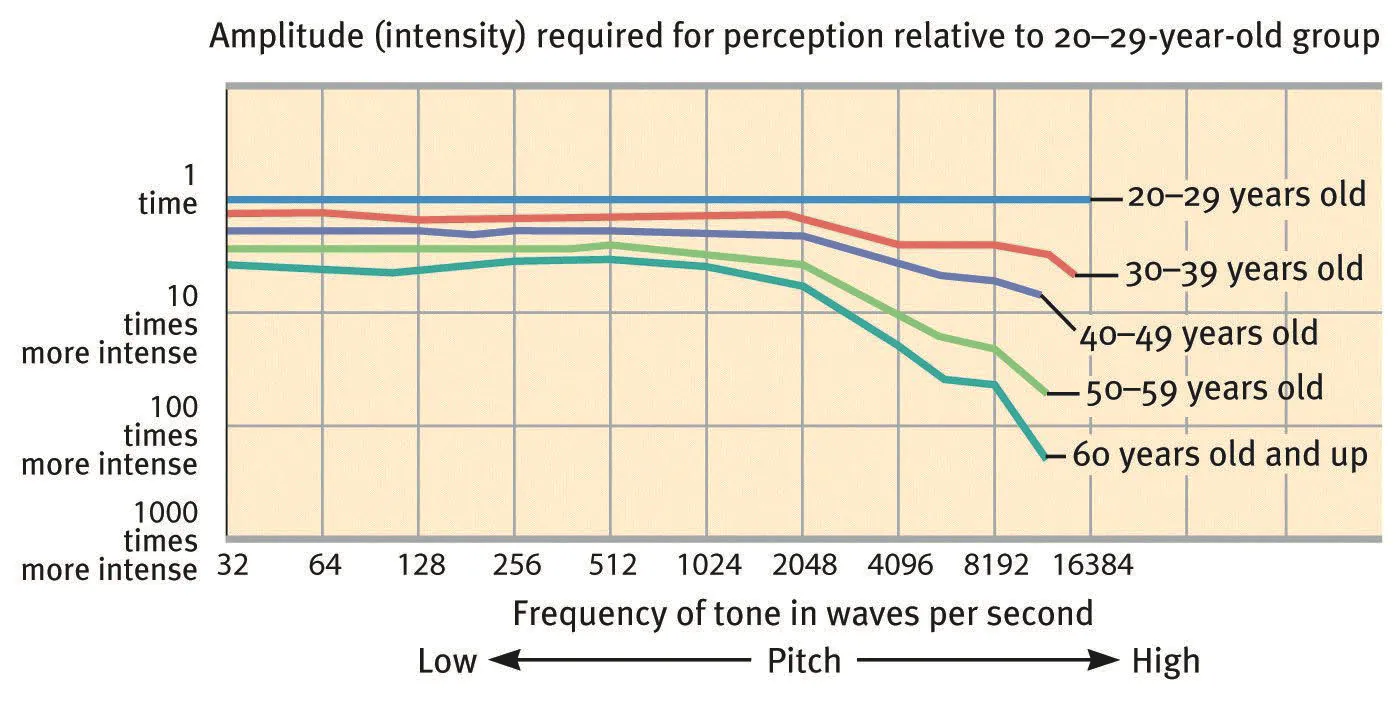
Deafness 聋
- Conduction Deafness, 声音无法传导到耳蜗 可以使用助听器
- Nerve Deafness, Hair Cell受损 需要移植耳蜗
Chemical Sense 味觉嗅觉
- 与听觉不同(通过能量 / 物理波传输),味觉和嗅觉通过化学传播
Taste 味觉
- We have bumps on our tongue called Papillae 突起
- Taste buds 味蕾 位于 Papillae (And the roof of the mouth)
- Sweet, salty, sour, bitter and recently umami / savory 鲜
- Bitterness detectors 苦味检测器,Critical because most poisons are bitter,检测毒物
- Sour detectors 酸味检测器,Detect bad foods,检测坏掉了的食物
- Built-in salt and sugar needs for survival 内置盐和糖的生存需求

Smell 嗅觉
- Cilia 纤毛,收集气味分子,Receptor cells that collect molecules of odor
- Olfactory Bulbs 绣球,Receives an electrical signal
and generates a “code” that is sent to the brain for
Interpretation,接收电信号并产生一个 “代码”,发送到大脑进行解释。
- 不通过 Thalamus 直接和 Limbic 连接
- 我们可以检测到超过 10,000 种气味,气味具有唤起记忆和感觉的能力
- Nasal Passage 鼻部通道
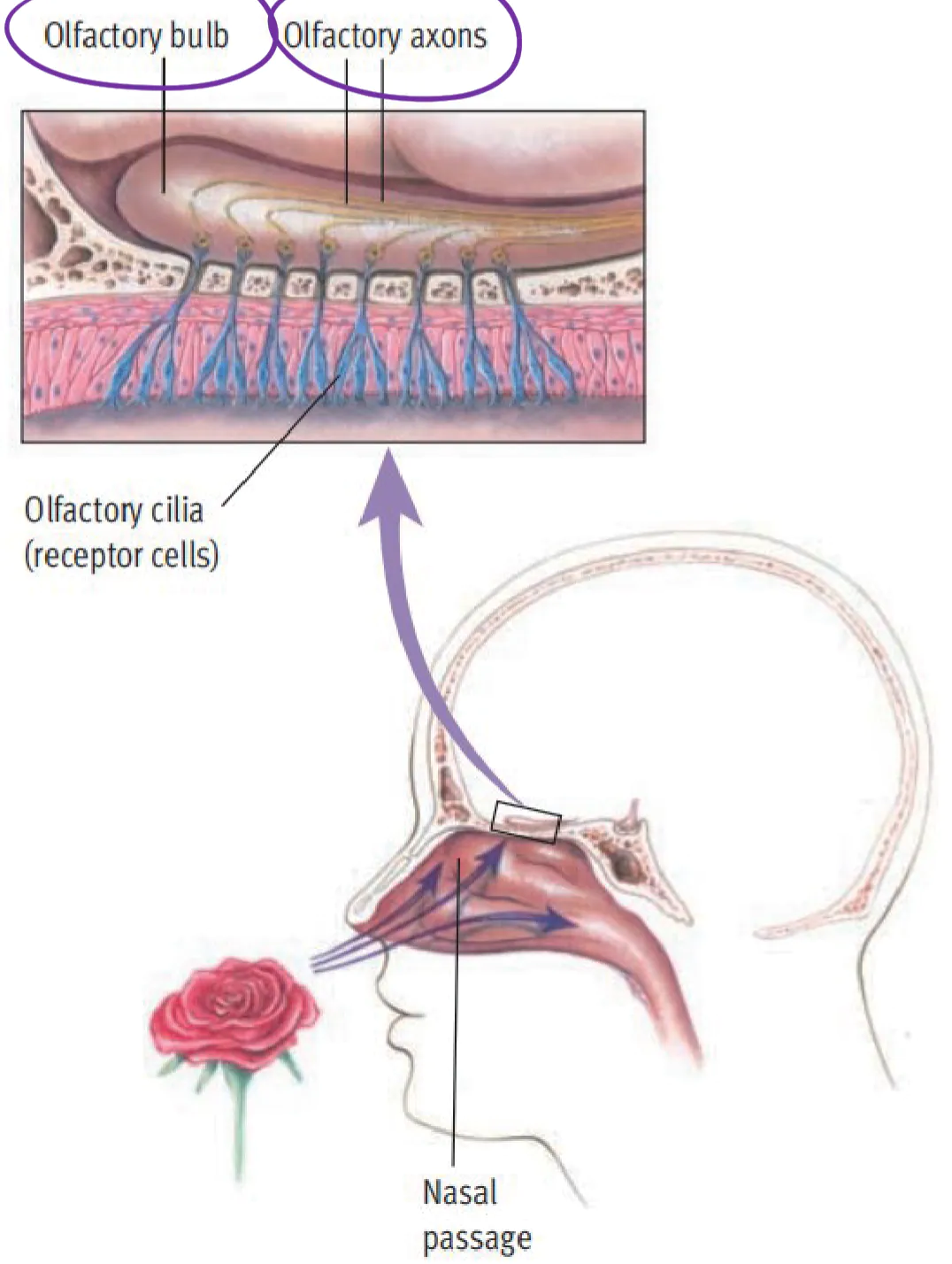
Body Sense 体觉
Vestibular Sense 前庭觉
- Tells us where our body is oriented in space
- Our sense of balance
- Located in our Semicircular Canals in our ears
- 告诉我们身体在空间中的方向
- 我们的平衡感
- 位于我们耳朵的半规管中
Kinesthesis 运动感
- 控制运动
Touch (Cutaneous Senses) 触觉
- Receptors 在我们的皮肤上
- 三种类型:压力 Pressure, 温度 Temperature,痛觉 Pain
Gate Control Theory of Pain 门控理论
门控理论(Gate-control Theory),是由梅尔扎克(Ronald Melzack,1973,1980)提出来的,它用来描述我们在痛觉中的这样一个现象:在我们感受到物理刺激时,却没有感到特别疼痛。
门控理论认为:脊髓中的一些细胞像门一样,切断和阻止一些痛觉信号进入大脑,使大脑感觉不到痛觉。广泛兴奋神经元的多突触作用在兴奋信号从传导末梢传入,同时内神经元也发出抑制信号,此时低强度的刺激可以激活抑制作用,同时抑制神经元对高强度刺激的响应。
有这样一个例子,当你全神贯注地在奔跑时,不小心摔了一下,站起来后你又继续跑,可能没有感觉到疼痛,因为脊髓中的一些细胞阻止了疼痛信息进入大脑,大脑无法感知,这就是门控理论所解释的现象。来自大脑的信息提供了所经历提供疼痛的背景信息。与门控理论相反的是痛觉神经矩阵理论(neuromatrix theory of pain),该理论也是由梅尔扎克(Ronald Melzack,1999)提出,这个理论认为,有时人们会在没有任何物理刺激的情况下感受到疼痛,即主观疼痛,这时,人们所经历的疼痛信息全部来自大脑,而非外界的物理刺激。
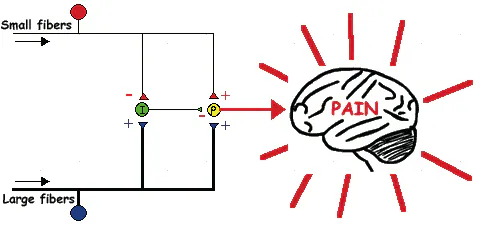
Learning 学习
Non-associative Learning 人类对环境的自然适应
- Habituation: When a stimulus repeatedly appears in the environment,
people will habituate to the stimulus
- 重复的刺激会被习惯
- Dishabituation a form of recovered or restored behavior a response
wherein the reaction towards a known stimulus is enhanced
- 过多重复的刺激会造成改变
- 在一个有噪音的空调房会慢慢适应,但是突然的杂音会让我们回到对空调噪音的敏感
- Sensitization: The opposite of habituation. An increase in
responsiveness due to a repeated application of a stimulus
- 对于刺激越来越敏感
- eg 蜘蛛
- Desensitization 脱敏: a decreased responsiveness
- 对于过多刺激不在作出反应
- 和dishabituation:dis是一开始就存在
Classical / Pavlovian conditioning 经典条件反射
- Definition: Classical conditioning occurs when a neutral stimulus, paired With a previously meaningful stimulus, eventually takes on some meaning itself
- Key Factors:
- Conditioned stimulus (CS) (neutral stimulus) 在反应前不会刺激 (训练后才会刺激 比如音叉)
- Unconditioned stimulus (US) 不需要反应就能刺激 (狗看到食物US本身天生就会刺激 必须要训练)
- Unconditioned response (UR)
- Conditioned response (CR)
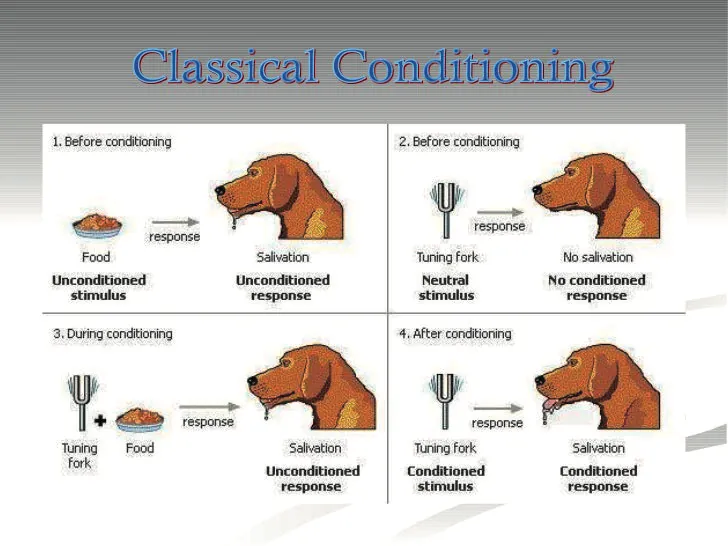
US v. CS
- Simultaneous conditioning: cs and US are presented at the same time
- Backward conditioning-us is presented first and is followed by the CS (ineffective)
- Forward conditioning-the CS is presented before the US
- Delay conditioning: CS is present until the US begins 无缝接轨
- Trace conditioning: CS is removed some time before the US is presented CS 时不时拿掉
Process
- Acquisition习得 : the neutral stimulus alone will evoke the conditional response
- Extinction: the elimination of the conditioned response. It wil
occur When we continuously present cs without us
- 过了很长时间 狗意识到了只有听到音叉不一定有食物 因此不在流口水
- Spontaneous recovery: The response recurs after the extinction of the behavior
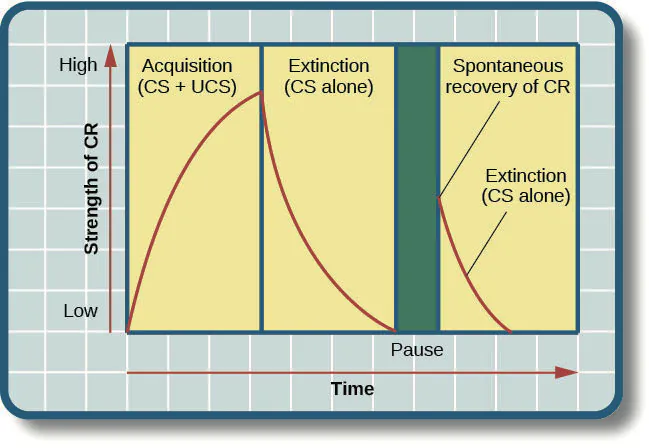
Little Albert Experiment
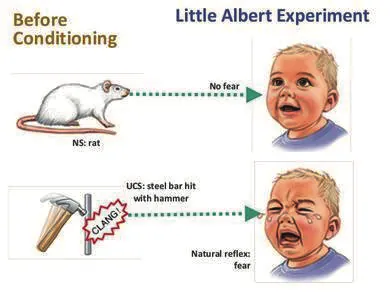
- Generalization: Tendency to respond to similar CSS
- 对小白鼠恐惧 → 对白毛恐惧
- Discrimination: Subiects can be trained to tell the difference
between stimulus
- 对小白鼠恐惧 → 不一定对白毛恐惧
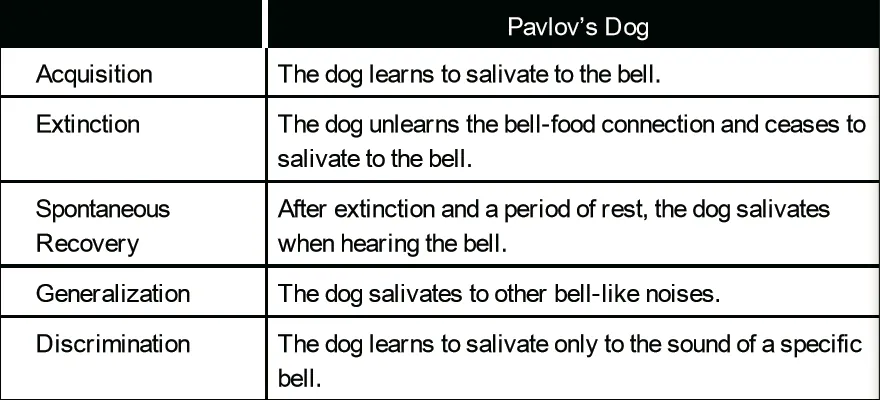
Aversive Conditioning
The Garcia Effect (conditioned taste aversion) is an aversion for a particular taste or smell that was associated With a negative reaction (such as nausea or vomiting)

Orders 学习可以嵌套
- First order conditioning: 原先的 食物 + CS
- Second order conditioning: a previous CS now is used as the US
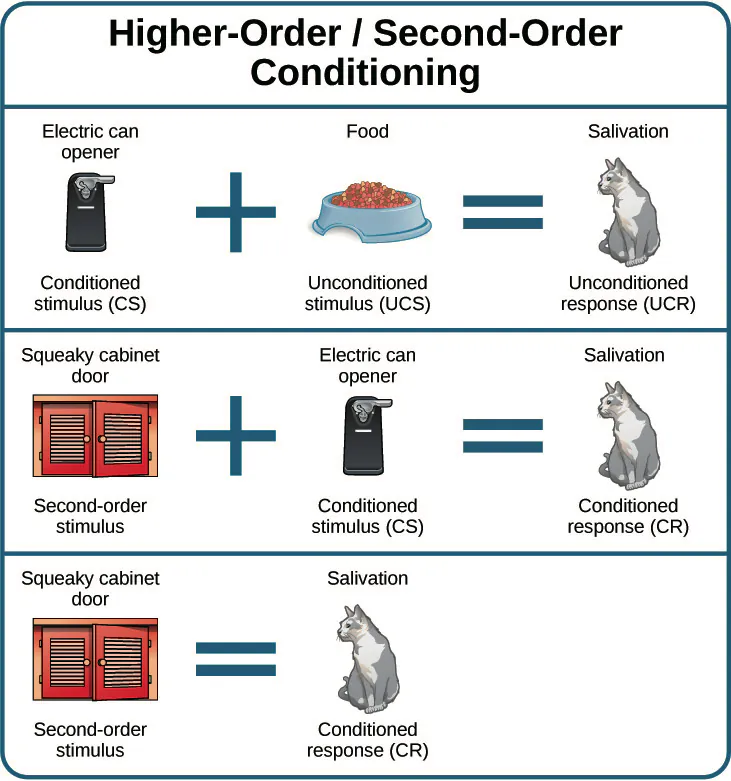
Operant Conditioning
- Operant Conditioning involves an organisms learning to make a response in order to obtain a reward or avoid punishment
- Law of effect: a behavior is more likely to recur if reinforced (Proposed by Edward L. Thorndike)
Skinner box
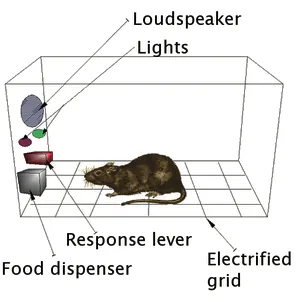
- factor:
- operant (response)
- reinforce
- primary (eg 食物、水)
- secondary (eg 钱 在后天学习后才认为)
- shaping: Differential reinforcement of successive approximation
- chaining: perform a number of response
- successively: in order to get a reward
Reinforcement & Punishment
- 强化
- 正强化 呈现愉快刺激 ++
- 不玩电脑,就给(呈现)你巧克力(愉快刺激)
- 负强化 消除厌恶刺激 —
- 不玩电脑,就不(消除)电(厌恶刺激)你
- 不想演讲,所以逃避(消除)演讲(厌恶刺激)
- 正强化 呈现愉快刺激 ++
- 惩罚
- 正惩罚 呈现厌恶刺激 +-
- 玩电脑,就会(呈现)电(厌恶刺激)你
- 负惩罚 消除愉快刺激 -+
- 玩电脑,就拿掉(消除)你的巧克力(愉快刺激)
- 正惩罚 呈现厌恶刺激 +-
Schedule Reward
- Continuous reinforcement: rewarding the behavior each time
- Fixed-ratio: provides reinforcement after a set number of responses.
- Variable-ratio: provides reinforcement after various number of responses
- Fixed-interval: after a set of interval
- Variable-interval: after various interval
- Variable schedules are more resistant to extinction than fixed schedules Variable的强化更加有效
Application of Reinforcement
- Taste Aversion 味觉厌恶
- Superstitious Behavior 迷信行为
- Law of Effect 效果律 (试错说)
- Learned Helpless 习得性无助
Escape and Avoidance
- Escape Learning: an individual learns how to get
away from an aversive stimulus by engaging in a particular behavior
- 肚子疼而逃避吃蔬菜
- Avoidance Learning: occurs when a person performs a
behavior to ensure an aversive stimulus is not presented
- 把蔬菜丢进垃圾桶而逃避吃蔬菜
- (The difference between escape and avoidance learning is that the conditioned stimulus is given before the presentation of an aversive stimulus.)
Social Learning
- Albert Bandura
- Modeling Observational learning
- Four Conditions for learning to occur
- The learner must pay attention to the behavior in question
- there must be retention of the observed behavior
- there must be a motivation for the learner to produce
- the behavior at a later time the learner must be able to reproduce the earned behavior
Bobo Doll Experiment (1961)
- Kids saw adults punching an inflated doll while narrating their aggressive behaviors such as kick him
- These kids were then put in a toy-deprived situation and acted out the same behavior they had seen
- 儿童会通过观察学习暴力行为

Cognitive learning
- Edward Tolman
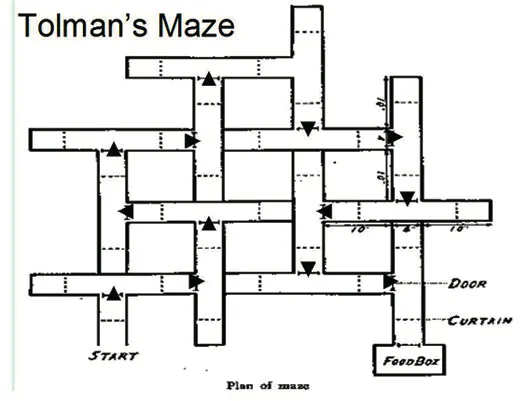
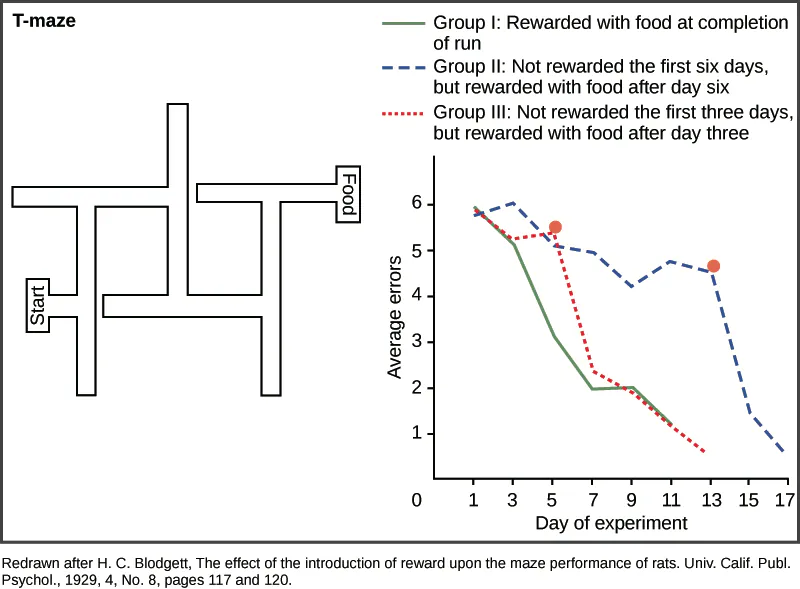
- What did Tolma ’s experiment tell us?
- Latent learning: learning that in not immediately
revealed through a change in behavior
- 学习成果不明显 需要context
- eg 沉浸在外语环境中自然会说外语, 不用看地图就知道上学的路
- Latent learning occurs Without obvious reinforcement
- Perception of the model and of themselves influence individuals earning
- Latent learning: learning that in not immediately
revealed through a change in behavior
- Abstract Learning: understand abstract behavior or meaning of abstract concept
- Insight Learning: occurs When one suddenly realizes how to solve a problem
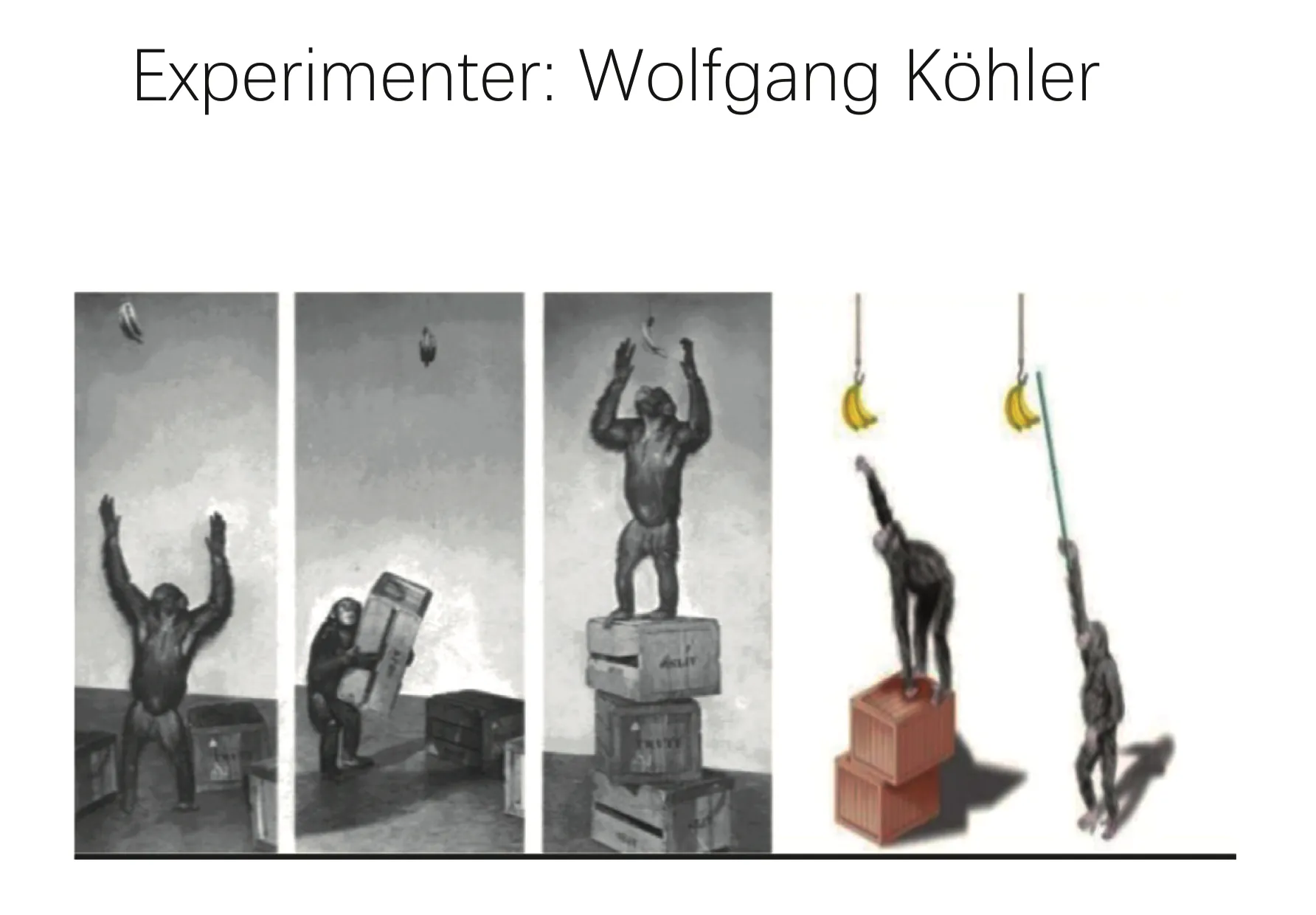
- Mirror Neuron (for Obersvaetional Learning): a neuron that fires both when an animal acts and when the animal observes the same action performed by another
- learning predispositions
- 在习得时 我们会偏向某个事物
- Biological preparedness
- 用于解释某些人产生的天生对事物的恐惧比其他恐惧更容易习得 eg 恐高
Biological
- Instinctive drift: The tendency for animals to forgo rewards to pursue their typical patterns of behavior
- Long-term potentiation (LTP)
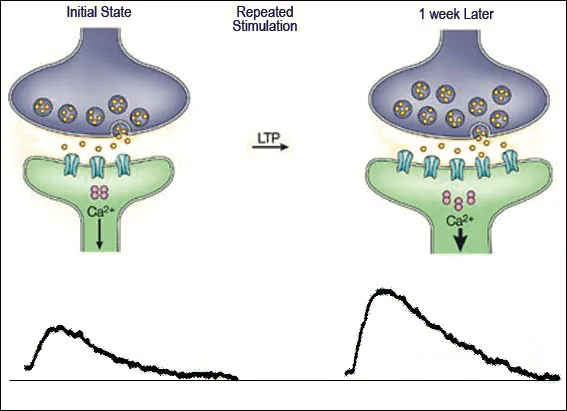
Cognitive Psychology
Models of Memory
Encoding is the ability to transform information so that it is easily processed by the nervous system. Examples of encoding can include mnemonic devices or repeated something out loud
- Context-dependent Learning – 根据周边的surroundings很容易想起来东西 e.g. 回母校,想起往事
- State-dependent Learning – 根据状态容易想起来的东西 e.g. 不开心的时候,想起以前不开心
- Divided Attention 分散注意 – 一边开车一边听音乐
- Inattentional Blindness 非注意盲视 – 听音乐太专注,导致眼睛看得不仔细,导致车祸
- ADHD (Attention deficit and hyperactivity disorder) 多动症
Storage is how one can maintain memory of information over a period of time. How much information that is stored is based on the effort that went into encoding it and how important the information is
Retrieval is the ability to obtain information that has been stored into the memory. Some people have photographic memories capable of retrieving any information they have seen or read
Short-Term Memory 短期记忆
- 10-30s
- 通过 组块 Chunking 扩张
- Rehearsal 可将短期记忆转为长期记忆
Long-Term Memory 长期记忆
- Episodic Memory 情景记忆:记住一件事的经历,比如小明第一次约小红出去玩
- Semantic Memory 语义记忆:记住事实,定义等书面的东西。比如背古文
- Procedural Memory 程序记忆:记住某件事的操作顺序,比如骑车和刷牙
Sensory Memory 感觉记忆 所有你所感受到的外部信息都会在感觉记忆里面非常短暂地停留处理。比如说你现在可以想起上一句话大概的位置和长度,这就是一种感觉记忆
- George Sperling曾经做过一个实验,把一个写了12个字母的矩阵呈现给被试,呈现的时间只有1/20秒,然后被试被要求回忆那些字母都是什么;结果发现被试虽然无法回忆出字母,但是可以说出这个矩阵的大概样子(即4*3排布),说明了这一整个表格一定很短暂地停留在感觉记忆里过;刚刚实验里这种视觉感觉记忆叫作
- 映像记忆(iconic memory):感官对于视觉的短暂记忆
- 回声记忆(echoic memory):感官对于听觉的短暂记忆
- Sensory Memory 都是不会被编码进短时记忆(Short-Term Memory)的,因为你平时并不会刻意记住自己眼睛上一秒看到的画面是什么
- 选择性注意(Selective Attention)决定哪些记忆会进入短时记忆进行处理
Prospective Memory 前瞻性记忆
- 记住将来打算要做的事情,比如你作业的 DDL
Implicit Memory (Procedural)内隐记忆
- 在无意识的情况下获得和使用的,可能会影响思想和行为
- Procedural Memory 程序记忆是最常见的形式之一,无意识任务
- 如何系鞋带或骑自行车时不需要刻意思考就会的过程
Explicit Memory (Semantic,Episodic)详述记忆
- Semantic Memory 语义记忆 和 Episodic 情景记忆都是详述记忆(Explicit Memory),因为你可以有意识地提取并用语言描述该种记忆
Forgetting and Memory Distortion 遗忘和记忆扭曲
Memory Decay 记忆衰退,字面意思 ### Interference 干扰
干扰(Interference)是产生 记忆变形(Memory Distortion)重要原因之一
Retroactive Interference 倒摄干扰
- 新学干涉旧学
Proactive Interference 前摄干扰
- 旧学干涉新学
Constructive Memory 虚构记忆
- 由 Elizabeth Loftus 提出
- 在别人的框架(Framing)的作用下虚构了记忆
- 警察问目击者,嫌疑人是不是穿黑色衣服,诱导目击者形成虚假回忆
Flynn Effect 弗林效应
- 对大众的智商测试结果是逐年升高的,因为越来越多人获得受教育的机会,社会的复杂度提高
- 当社会更复杂,人们接受的刺激较多,智力也就更高
Stereotype Threat 刻板印象威胁
- 自我证实效应(Self-Confirming),指一个人被固有的他人的成见干扰而影响自己的能力。
- 许多人认为女生在数学上都普遍学得吃力,一个女生就受到了这个刻板印象的负面影响,自我暗示从而学得真的不好,考试成绩就会下降
- 自我证实效应(Self-Confirming),指一个人被固有的他人的成见干扰而影响自己的能力。
Savant Syndrome 学者综合征
- 一个智力不足的人在某个领域表现出超乎常人的能力
Stanford-Binet Test 斯坦福比奈测试
- (mental age / chronological) * 100 = IQ
Sensory Memory
- The gateway between perception and Memory
- Iconic Echoic
- Iconic Memory- Visual 视觉记忆
- George Sperling Experiment
- 让受试者背单词 要求认识单词的大概读音就行 发现了sensory memory 维持时间很短
- Capacity is quite large, but duration is short 容量大 但是短期
- Only lasts for a few tenths of a second 视觉暂留
- Visual persistence
- George Sperling Experiment
- Echoic Memory- Auditory 听觉记忆
- Lasts for three or four seconds Once encoded 比视觉长
- Selective Attention
Short Term Memory
- Also called working memory because these are
memories we are currently working
with(我们现在想的注意到的都是在这层级。)
- working memory 对信息的进一步整合
- short term memory 对信息的单纯处理
- Duration: a few seconds up to about a minute 比sensory memory 长
- Primarily acoustically coded (George Miller)
- Capacity: 7+-2 (seven items plus or minus two)
延长短期记忆: Maintained by Rehearsal
Maintenance rehearsal: simple repetition 死记硬背 重复
Elaborative rehearsal: involves organization and understanding of the information eg 联想记忆
短期记忆 Serial Position Effect
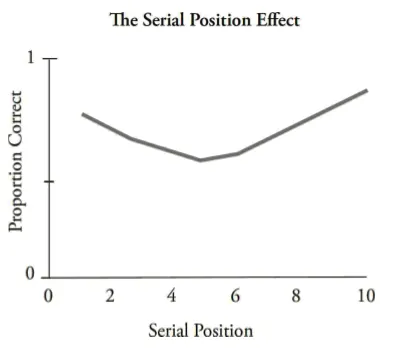
Tend to store items from a list sequentially
Primacy effect: remembering the first items better
recency effect: remembering the last items better
如果同时记忆一组数据,数据前后端被记忆的效果更高
Long term Memory
- Our permanent storage
- Capacity: unlimited 没有极限
- Three Formats

Flashbulb memory (属于 Episodic): a very deep, vivid memory in the form of a visual mage associated with a particular emotionally arousing event eg大地震
Explicit: Episodic, Flashbulb
关键:可以清晰描述
Implicit: Semantic, Procedural
关键:不可言传 但是知道如何使用
Ex 和 Im 记忆在大脑中处理部分不同 - Semantic Network 语义网络 – 信息在脑中像网络一样存起来 - Connectionist or Parallel Distributed Processing (PDP) Model 同时分布性处理模型 – 看、听同时处理 - Conceptual Hierarchy 概念层次结构 ### Technique for LTM 如何提高(长期)记忆力
- Chunking: group items into units 分组记忆
- Mnemonic device 记忆技巧
- memory palace / loci
- Dual-coding hypothesis 通过同时图像和声音记忆
- Self-reference effect 用自己(作为例子)来解释 让信息变得和自己有关 以便加深记忆
Level of Processing
Memories are deeply (or elaborately) processed or shallowly (or maintenance) processed
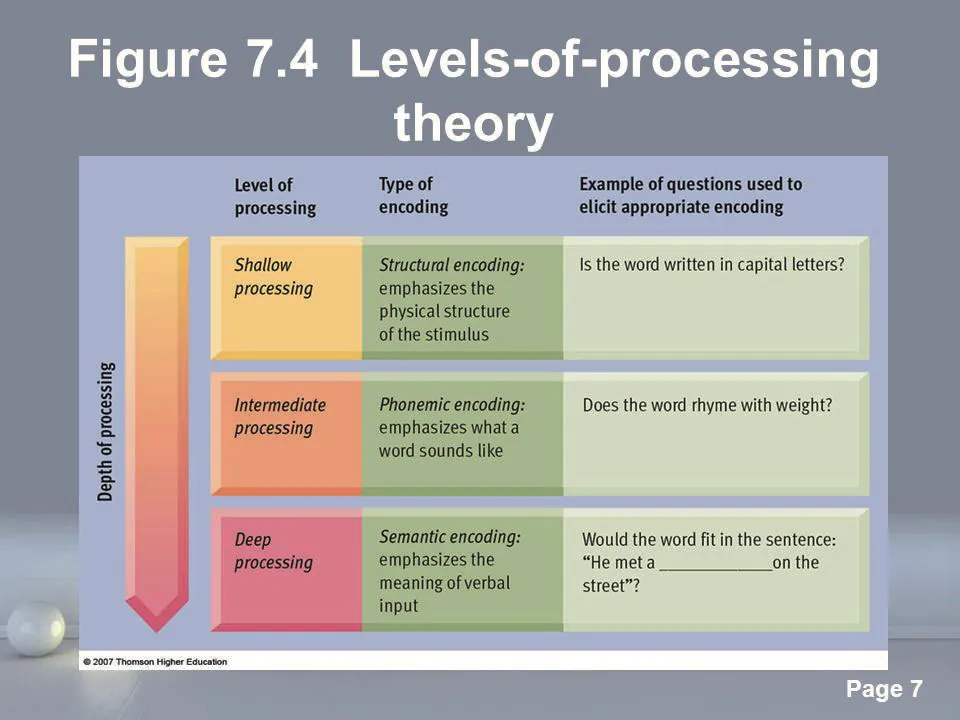
- shallow: 表面上处理 eg 单词的拼写
- intermediate: 韵律方面的处理 eg 辨别单词的音节
- deep: 意思的处理 eg 单词词性 用法 解释
记忆的遗忘 Decay or interference
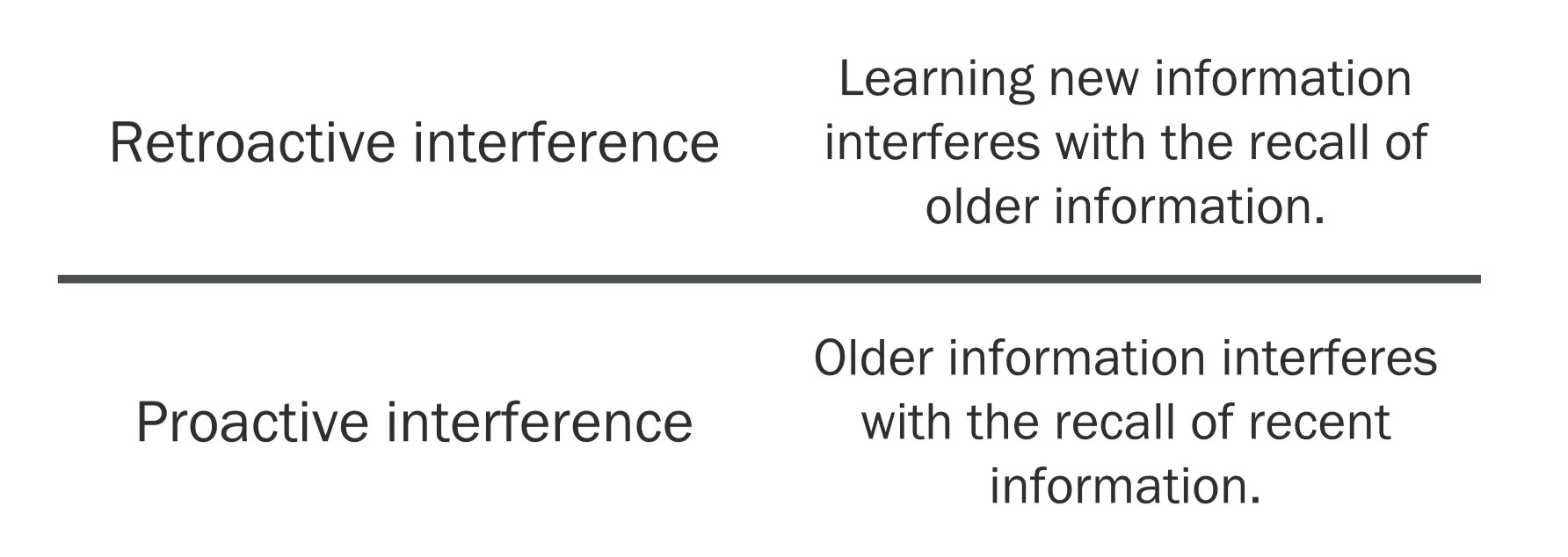
- Retroactive: 新的信息活跃 从而忘记久的信息 eg 在国外呆久了 从而对中文生疏
- Proactive: 旧的信息活跃 忘记新的信息
Retrieval
Recognition 识别: Matching a current event or fact with one already in memory 把记忆和现在场景对应
eg 考试做题 把题目和记忆对起来
Recall : State-dependent memory and Context-dependent memory
eg 如果站着背单词 那么回忆的时候站着会比坐着容易
Tip-of-the-tongue-phenomenon: temporary inability to recall information 短暂性的失忆
解决(减少)方法 : semantic network theory 建立记忆的逻辑
Biological Basis
- Hippocampus is important in
encoding new memories
- anterograde amnesia 无法形成新的记忆 但是之前的记忆还是完整
- Retrograde amnesia 无法回忆 但是可以记忆新事物
LTP. Neutral connection
Constructive Memory
- Memory reconstruction: occurs when we fit together
pieces of an event that seem likely (Source amnesia is one likely cause
of memory reconstruction.)
- 我们会把几个不同的记忆编织在一起
- Elizabeth Loftus studied on false memory
- Framing: repeated suggestions and misleading questions can
create false memories
- 暗示性的问题或者言辞会让人的记忆发生改变
Language
Features of language
Language: a set old spoken, written, or signed words and the way we combine them to communicate meaning
- Arbitrary 2. A structure 3. Multiplicity of structure 4, Productive 5. Dynamic
Elements of language
Phonemes: the smallest units of sound 最小的发声单位
Morpheme: the smallest unit of meaningful sound. 最小的有意义的单位
Syntax: the grammar of a language 语法
Semantics: Rules that establish the meaning of a sentence 句法
language acquisition
- Babbling
- About 4 months, infant spontaneously utters various sounds at first unrelated to the household language
- 婴儿在4月的时候吐出无意义的声音 和语言无关
- One-word stage/ holophrastic stage
- About age 1 to 2, during which a child speaks mostly in a single words
- eg 叫爸爸妈妈
- Two-word stage/telegraphic stage
- The beginning about age 2, a child speaks mostly in 2-words statements
- 简单的对话
- Overgeneralization 现象
- Children gradually increase their ability to combine words in proper syntax if these used are molded for them
- A misapplication of grammar rules ### Acquisition 语言的习得
- 因为各个语言语法相似,所以Language Acquisition Device(语言习得装置)应该是人类共有
- Cooing stage:在婴儿4个月之前,会发出各种 Ah-goo 的声音,没有实际的含义
- Babbling stage:在婴儿4个月的时候,在练习音素(Phoneme)的发音,这个阶段的婴儿是可以发出世界上所有语言的音素的。但是在我们成长过程中我们会保留发出母语音素的能力而失去发出其他所有别的语言的音素的能力
- Holophrastic stage/one word stage:在12个月时,开始模仿他们听到的词语(Morpheme),用一个单词来代替一句话表达语义
- Two-word
stage:在24个月时,他可以把单词拼凑在一起,语义(Semantics)已经完整了,但是句法还没有
- 这个阶段的婴儿已经开始学习句法(Syntax)和语法了,只是有时候会用错。
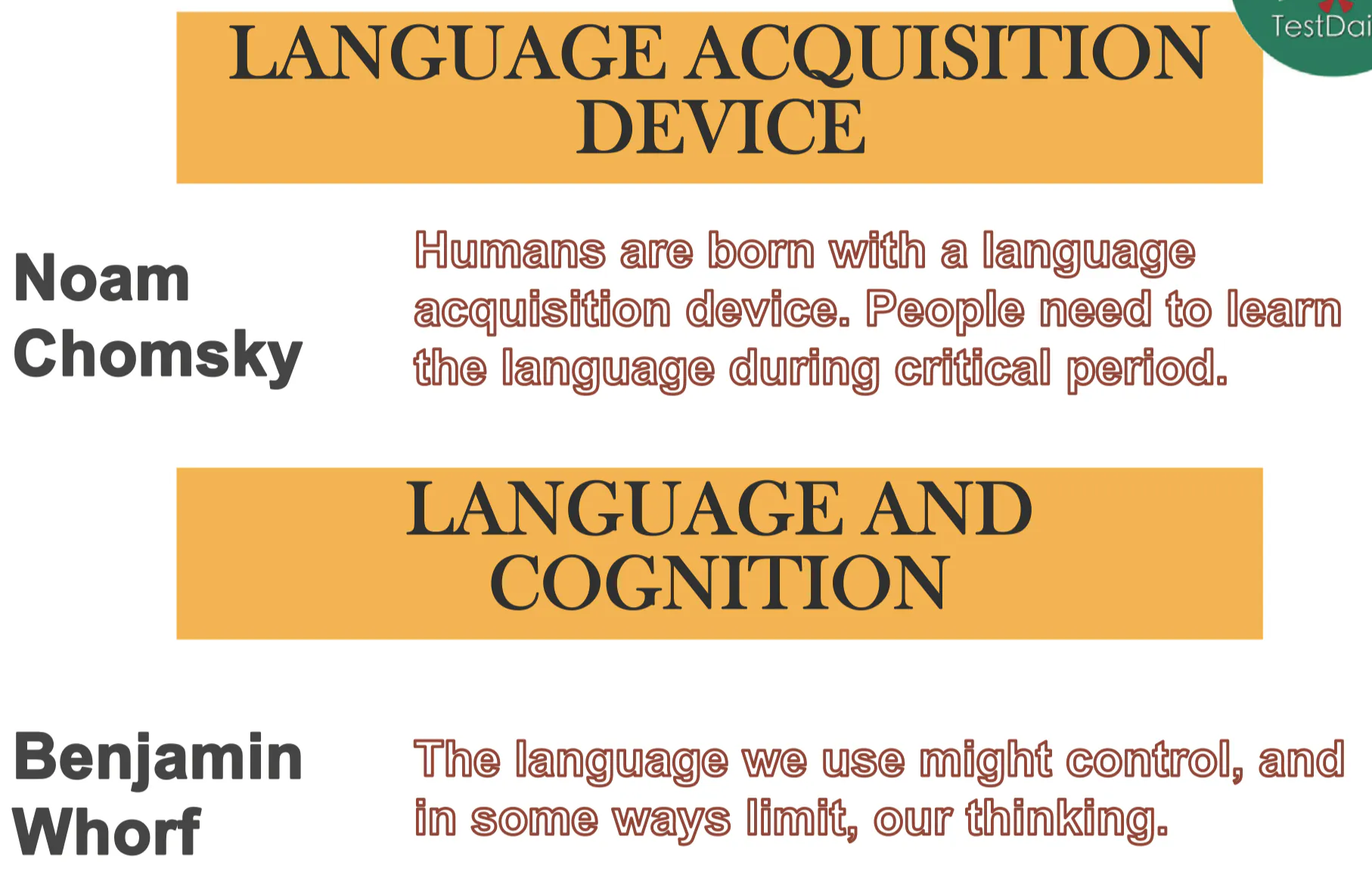
- Chomsky:语言学习需要在一定时期内发展,如果过了这个时期就会很难
- Whorf:语言会控制或者限制我们的思维模式 eg 某个文化中可能缺少一些其他文化的单词
Thinking
Basic Concept Subordinate Concept
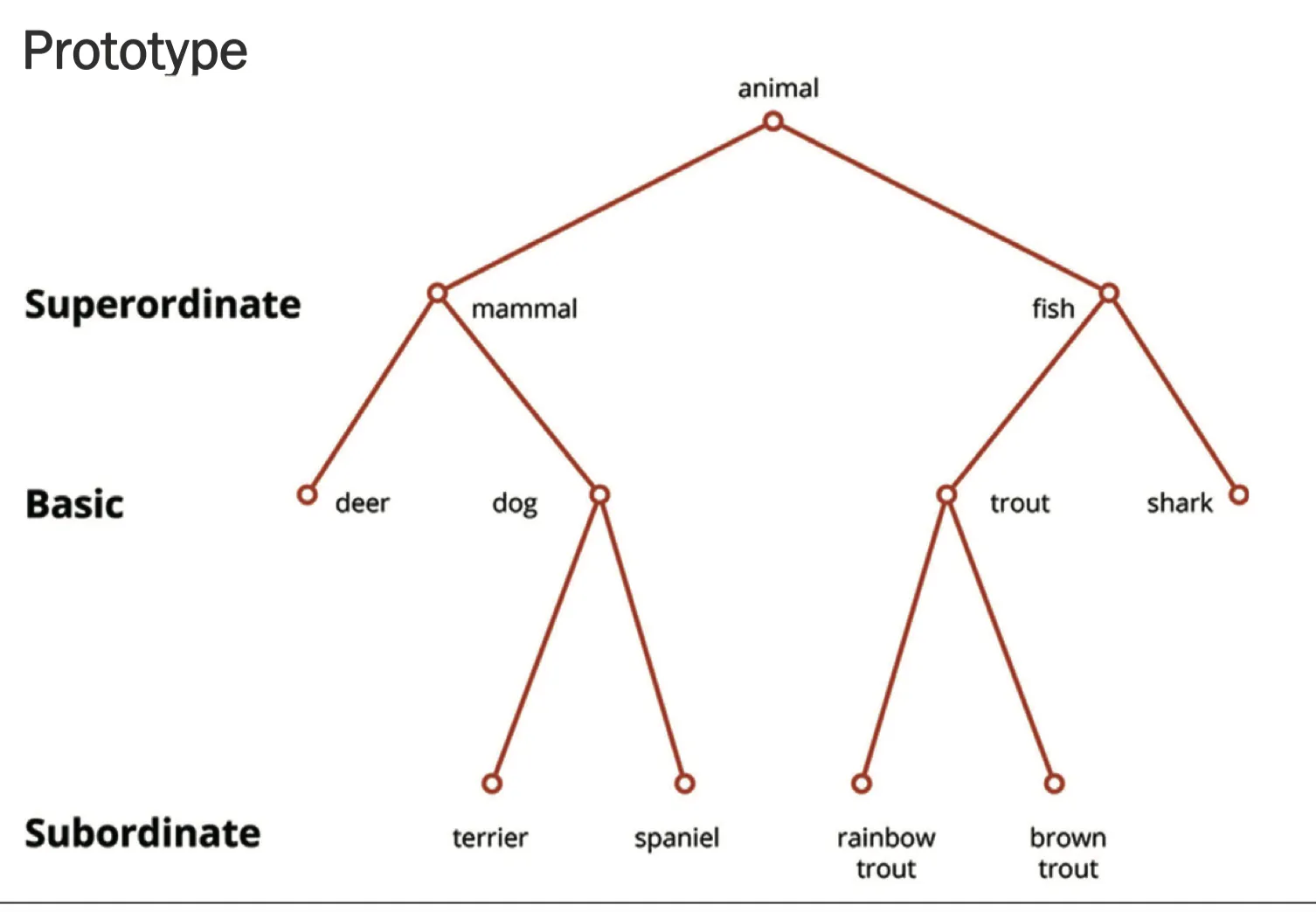
Problem Solving
- Algorithms 算法 (bottom to up)
- Logical, methodical, step by step procedure that eventually guarantees as a solution, but maybe slow to work through
- Heuristics 启发法 (up to down)
- Simple strategy that allows us to solve problems faster, although moavare error-prone than an algorithm
- Availability Heuristic 获得性启发
- Rules of thumb is judged by what events some readily to mind
- 脑子里刚出现的内容作为参考
- Representativeness Heuristic 代表性启发
- Judging a situation based on how similar the aspects are to the prototypes the person holds in his or her mind
- 和 prototype 进行对比
Rigidity 思维僵化
- Functional fixedness 功能固化
- The inability to see a new use of an object
- 只能看到某个物体的原本作用 eg 书除了看还能垫桌角
- Confirmation bias 确认偏见
- The tendency to look for and favor evidence that confirms our ideas while avoiding or ignoring evidence to the contrary
- 一旦认定某个观点而刻意忽略不同意见
- eg 收集单方面观点
- Belief Perseverance
- The tendency to cling to initial conceptions or belief despite proof the contrary
- 一旦认定某个观点 (被动)忽略不同意见
- eg 对于反对视而不见
- Framing affect 框架效应
- How an issue is posed or presented-framing can significantly affect decisions and judgments
- Divergent thinking 发散性思维 (Creativity)
- In order to solve problems, we must decide whether the problem has one or more solutions If many correct answers are possible, we use a process know as divergent thinking
- Convergent thinking 收敛思维
- If the problem can be solved only by one answer, we know it as convergent thinking
Testing
Standarization
Standardization implies uniformity of procedures in administrating and scoring the test
Sample: representation of whole population
Flynn Effect the phenomenon in which there is a marked increase in intelligence test score averages over time
VALIDITY&RELIABILAY
Validity: The indication of how sound the research is (Whether the result is accurate and close to true value.
Reliability: extent to which a psychology research is consistent (whether a research can easily be repeated and yield the same results each time.
Validity
Content validity: how well a test measures the behavior for which it is intended
Face validity: Face validity is defined as the degree to which a test seems to measure what it reports to measure 从外表看研究是否可以达到期望目的
Construct Validity Construct validity can be viewed as an overarching term to assess the validity of the measurement procedure (e. G, a questionnaire) that you use to measure a given construct (e. G, depression, commitment trust, etc. 研究是否可以测量相应目标
Criterion-related validity: refers to the degree to which a measurement can accurately predict specific criterion variables
Concurrent validity 是否与现在研究符合
Predictive validity 是否可以预测
- External validity: measures the extent to which an
experiment can be generalized to create general rules that can be
applied in other, real life situations
- 是否可以推广到更大人群
- Internal validity: whether the effects observed in a study are due to the manipulation of the independent variable and not some other factor
Intelligence
Theory of Intelligence
- Key people: Charles Spearman
- G factor (general intelligence): refers to the existence of a broad mental capacity that influences performance on cognitive ability measures
- 整体能力 作为地基存在
- Fluid Intelligence: the ability to reason in a logical manner and solve problems, independent of learned knowledge or experience
- Crystal Intelligence: the ability to use skills, knowledge, and experience
- Key people: Howard Gardner
- Multiple intelligence- linguistic, logical-mathematical, spatial musical, bodily-kinesthetic, interpersonal, intrapersonal, and naturalist Intelligence
- Key people: Daniel Goleman
- Emotional intelligence the ability to monitor your own emotions as well as others, to distinguish and label different emotions correctly and to use emotional information to guide thinking and behavior with yourself and others
- Key people: Robert Sternberg
- Triarchic theory
- Analytic/component intelligence
- Experiential/creative intelligence
- Contextual/ practical intelligence
- Triarchic theory
Intelligence Test 智力测试
- Stanford-binet IQ test: The Stanford-binet test is
a examination meant to gauge intelligence through five factors of
cognitive ability. These five factors include fluid reasoning,
knowledge, quantitative reasoning, visual-spatial processing and working
memory. Both verbal and nonverbal responses
are measured
- Key people: Louis Terman Alfred Binet
- 得出比例 mental age/real age 不适合成人
- Key people: David Wechsler
- The Wechsler adult intelligence scale (WAIS)
- The Wechsler intelligence scale for children (WISC)
- The Wechsler preschool and primary scale of intelligence (WPPSI)
- 更具分布来得出结果
Discussion on Intelligence
Appendix
Stereotype threat is the fear or anxiety of confirming a negative stereotype about one’s social group
Homeostasis, from the Greek words for “same” and “steady,” refers to any process that living things use to actively maintain fairly stable conditions necessary for survival.
Automatic Processing 肌肉记忆
cognitive dissonance is used to describe the mental discomfort that results from holding two conflicting beliefs, values, or attitudes
spacing effect is the observation that repetitions spaced in time tend to produce stronger memories than repetitions massed closer together in time
The mood-congruent memory effect states that happy people will better remember happy than sad materials
Bodily-kinesthetic is a learning style often referred to as learning with the hands’ or physical learning
Existential intelligence involves an individual’s ability to use collective values and intuition to understand - others and the world around them.
Nonsense Syllables 无意义音节 – 实验的方法就是让人背这个
Retention 保持量 – 还记得多少
Saving Score 节省分数 – 一个指标:背过一次,再背一遍,两次花费的时间之差
Recall 回忆 – 完全靠自身想
Recognition 再认 – 从一堆选项中选出之前看到哪个(比Recall简单)
